#old neighborhood Amsterdam east
Text
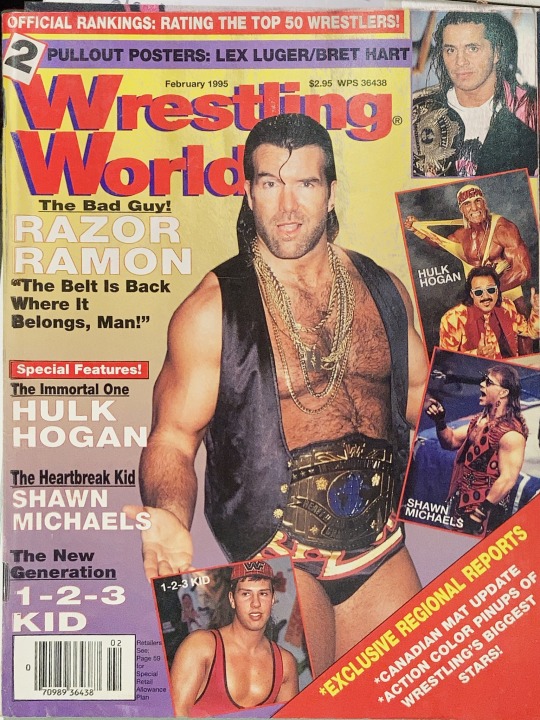

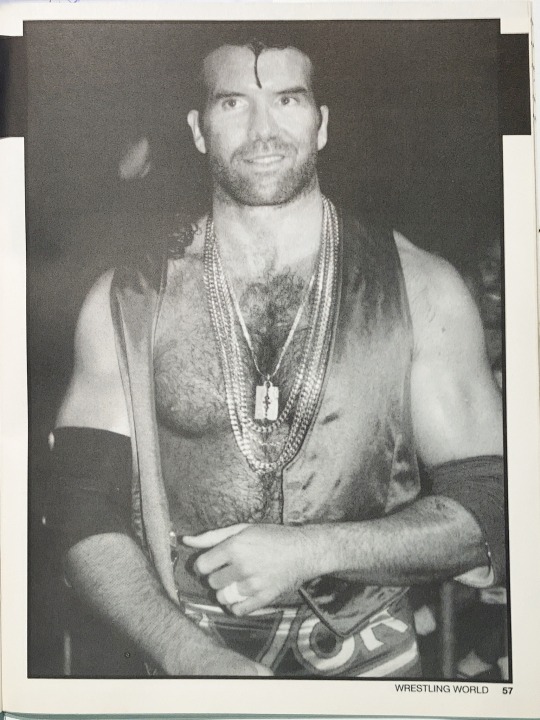


Wrestling World : FEBRUARY 1995
A NIGHT OUT WITH THE BAD GUY
You’ve seen what he can do in the ring. Now, Wrestling World shows you what he’s like outside the ropes! Get ready for a night on the town with Razor Ramon.
By Jose Padua
THIS IS A story about good versus evil, money versus poverty, knowledge versus ignorance. It’s a story about the subtle power of poetry versus the blunt force of a closed fist, the seductive charm of a beautiful woman versus the explosive temper of a maniacal beast. But it’s mostly a story about a guy with a toothpick in his mouth whose perpetual five o’clock shadow bespeaks of street fights, hard times, and a distaste for proper grooming-though not necessarily in that order.
We’re referring, of course, to “The Bad Guy,” Razor Ramon, that hairy behemoth of a man who since bursting onto the scene in the WWF a few years ago has made an impression on wrestling fans all over the world. That it’s a “bad” impression is, as wrestling fans have learned, no reason to shun him. On the contrary, it is the very reason we have all embraced his aura and taken him for what he truly is-a man who has weathered “the dark night of the soul” and come out on top to server as both inspiration for us working stiffs, and as a role model for today’s youth culture.
Indeed, Razor’s influence has extended well beyond the world of wrestling to the point that he’s become something of a hero to fans of the alternative music scene. Nowadays it’s just as common for hip twentysomethings to identify themselves by purchasing a block of tickets to a Pearl Jam concert as it is for them to sport a Razor Ramon tee shirt complete with paint stains and strategically placed rips in the cloth. And one recent Friday night found “The Bad Guy” in the company of some of that very same crowd.
Celebrating his recent victory over Diesel for the Intercontinental title, Razor was having dinner at a Mexican restaurant on the corner of Amsterdam Avenue and 89th St. in Manhattan. Although he’s been known to frequent such posh restaurants as Alla Sera on the Upper East Side, this was a much more modest place.
“I like it here,” Razor explains. “Though sometimes I go to them fancy restaurants, I always have a better time at places like this. Places where real people go to have a good time.”
Success, it seems, has not gone to Razor’s head: He’s the people’s bad guy. But that wasn’t always the case.
“When I first started out. I was just like Shawn Michaels,” he continued, bringing up the source of his major feuds. “I was bad for the wrong reasons, Chico, stepping all over my people, people who had it rough like me…who came from the streets like me. But I learned to have respect for my roots, man.”
Among his entourage this evening are a couple of kids sporting the grunge look, some pals from the old neighborhood, and a former centerfold model named Lisa. When the waiter comes to take everyone’s order we hear requests for standard Mexican fare-dishes such as enchiladas, tacos, chimichangas- until it’s Razor’s turn to order. Pulling the toothpick from his mouth, Razor looks intently at the waiter and says, “I’d like a special order, Chico. Fried chicken.” It seemed an odd choice, but no one’s going to argue with Razor about what he wants to eat. If he were to order spaghetti and meatballs at a Chinese restaurant he’d undoubtedly be obliged.
While waiting for dinner the subject of The 1-2-3 Kid comes up. Razor’s unexpected defeat the the hands of The 1-2-3 Kid was the turning point in his career, the darkness merged-where the void and the bad kicked out the ugly to create a force Razor never imagined could exist.
“My Main Man,” Razor says, referring to The Kid. “He took me by surprise, Chico. Here was this little guy who could wrestle with the biggest dudes, man. He showed me that you could be ‘good’ too.”
“So now you’re The Good Guy?” we ask.
“No, I’m The Bad Guy. But now I understand what’s good. See why I’m sayin’?”
Whatever the case may be, Razor’s style is, to say the least, different from that of The 1-2-3 Kid. Where The Kid is all finesse and dazzling acrobatics, Razor is brute force and methodical determination. In fact, if football announcer John Madden were to open his “All-Madden” team to professional wrestlers, Razor Ramon would be first on his list. Not necessarily the most skilled or scientific, Madden’s team is made up of real “tough guys,” the ones who are most willing to get down in the dirt and do whatever it takes to win-which is as good a description as any of Razor Ramon’s “bad” style.
[Razor Ramon cuts a striking figure in, or out, of the ring!]
When dinner is served Razor immediately digs in with his hands. Picking up a drumstick, he devours it in a single sloppy bite, then wipes his mouth with the back of his hand: Like his wrestling style, his table manners aren’t all that elegant. But what matters most is that they get the job done. “Anyone want to try some of this chicken?” he asks, looking around at his guests. “It’s good.”
After dinner Razor and his friends pile into a couple of cabs and head downtown to the East Village. Getting off on Avenue B, they gather in front of a grimy performance space that goes by the name of Chez Rollo where down-and-out writers congregate to spit out words of rage and wisdom. It seems that although Razor is known for a lot of things, one thing that never gets much attention is the fact that he is something of a patron of the arts-especially those arts that speak of the street, of that world from whence he came. On entering, Razor is immediately recognized by a number of people, including a couple of the poets.
“Hey Razor!” says one of them. The poet walks up to Razor and introduces himself. “I’m Carl Watson; I’m a big fan of yours.”
“Oh yeah,” says Razor nodding. “I know your work. I like it…it’s good stuff, Chico.”
While waiting for the reading to begin Carl explains how he became a fan of “The Bad Guy.” “I got into wrestling when I got an assignment to do a story on Lucha Libre for the Village Voice,” he says. “After going to some the Lucha Libre matches in Brooklyn I started to watch the WWF or get some perspective on how the Luca Libre scene differs from other wrestling promotions, and of all the wrestlers there the one who really stood out the most was Razor Ramon-‘The Bad Guy.’ He’s got the good, Chico.”
Soon the reading starts. First is Ron Kolm, who reads a series of short, insightful poems on such diverse topics as getting drunk and going to war.
“He’s bad,” Razor comments.
“You mean you don’t like him?” Lisa asks.
“No, I mean he’s bad. Like me.” Later on Carl gets up and reads a story about the seedy side of the city and life spent in dingy bars and transient hotels.
“He’s been there, man,” Razor comments nodding his head appreciatively.
Last is a guy named Bob wearing a pork pie hat, a polka dot shirt, and baggy black trousers. Like Razor he also sports a good amount of stubble on his cheeks, but on seeing him Razor starts to sneer. “Something ain’t right with this dude,” he says shaking his head.
Bob commences his portion of the reading with an attempt at rap style poetry. Watching Bob perform, Razor gets agitated, shifting in his seat and clenching his fists. “He don’t know what he’s talking about,” Razor mumbles.
“He’s acting like he’s down, but it ain’t no way, Chico. He’s a poseur just like Shawn Michaels.” A few poems later Razor stands up in anger and is about to approach the stage when Lisa stops him.
“Hey, Razor, it’s okay,” she says. “He’s harmless.”
“Yeah, but someone needs to make this gringo shut up.”
Luckily for Bob it’s the last poem of the night, but before he steps down Razor yells a warning toward the stage: “It’s all right for now. But I’ll be back, Chico.”
In need of a nightcap, Razor leads his entourage, which at this point includes Ron and Carl, to The International Bar on First Avenue. Taking a nip from a bottle of Dos Equis, he begins to relax again. Later in the evening, at that point when most people take to reminiscing about the past, Razor Ramon (always one to do things his own way), looks instead toward the future.
“I’m the Intercontinental champion now,” he tells Ron, who hangs on the Razor’s every word, “and it feels good, Chico. But pretty soon I’m going to get a shot at the big title. And you know, to have me go against Bret Hart will be one of the greatest matches of all time. The two baddest guys in the WWF. But first there are some people who need to be taught a lesson. People like the Million Dollar Man. Bam Bam Bigelow, and Jeff Jarrett. They make me mad, Chico.”
“And don’t forget Bob, the bad poet,” Ron suggests.
“Bad? He ain’t bad, Chico,” Razor says raising his voice.
“Well…I mean Bob the good poet.”
“He ain’t good either.”
“Well, you know what I mean…” Ron says nervously. Then adds. “I better shut up.”
“Hey, Chico, it’s cool, man. Don’t sweat the small stuff.”
Razor picks the tab up from the bar, lays down a couple of hundred dollar bills, then lifts his bottle and extends it towards Ron and the rest of the group.
“To all my good friends.”
And so ends a night out with The Bad Guy. A night which despite the occasional misunderstanding, turned out to be a good one. Or should we say a bad one. Whatever the proper word is, it’s a distinction that Razor Ramon understands very well, and perhaps one day when the time is right he’ll teach us all a lesson.
[Inspired by the work of Ron Kolm and Carl Watson, Razor tries his hand at writing some poetry!]
#wwf#world wrestling federation#razor Ramon#I loved this article#it was so fun! I might try to get more of these wrestling world just for these articles#magazine scan#magazine transcript
23 notes
·
View notes
Text
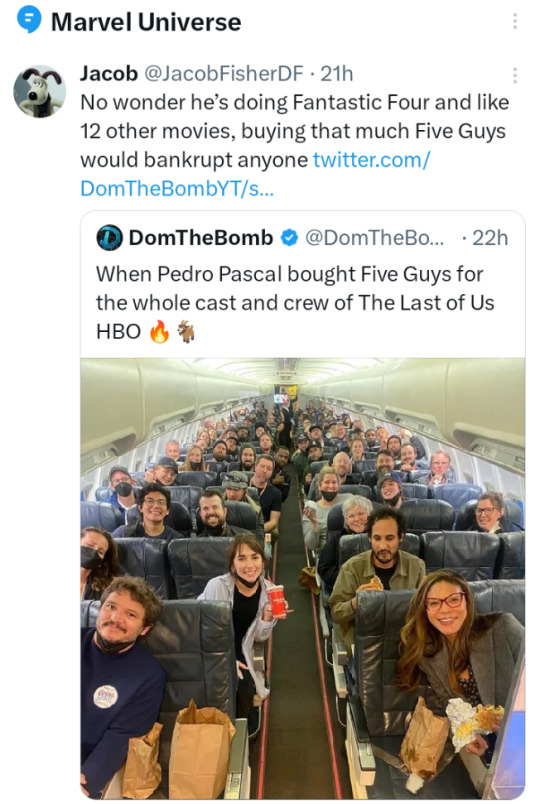
Five Guys was founded in 1986 by Janie and Jerry Murrell. Jerry and the couple's sons Jim, Matt, Chad, and Ben were the original "Five Guys". The Murrells had a fifth son, Tyler, two years later. Today, all five sons, the current "Five Guys", are involved in the business: Matt and Jim travel the United States visiting stores, Chad oversees training, Ben selects the franchisees, and Tyler runs the bakery.
The first Five Guys was in Arlington's Westmont Shopping Center. Buns were baked in the same center by Brenner's Bakery. This location closed, in favor of another in Alexandria, Virginia, at the intersection of King and North Beauregard Streets, which closed on September 21, 2013.
More followed in Old Town Alexandria and Springfield, Virginia, making five locations open by 2001. Their success encouraged the Murrells to franchise their concept the following year, engaging Fransmart, a franchise sales organization. Former American football player Mark Moseley, who had gone to work for Fransmart after his football career, played a key role in Five Guys' expansion and went on to become the company's director of franchise development after it ended its business relationship with Fransmart. In early 2003, the chain began franchising, opening the doors to rapid expansion which caught the attention of national restaurant trade organizations and the national press. The expansion started in Virginia and Maryland, and by the end of 2004, over 300 units were in development through the Northeast. Over the next few years, the chain rapidly expanded across the entire United States and into Canada, reaching over 1,000 locations by 2012.[needs update][citation needed]
The first location outside North America opened in the United Kingdom in July 2013, in London on Long Acre in Covent Garden. The chain now has more than 150 restaurants in the UK. Five Guys also has locations in the Middle East and has continued to expand in Europe. In late 2017, Five Guys opened its first restaurants in Germany, with a branch in Frankfurt and another in Essen.
Five Guys, one of the top three burgers in the U.S., opened its first Korean store in Gangnam, Seoul, at 11 a.m. on June 26, 2023 with a countdown shout. As of 2024, there are a total of four branches in Seoul.
Five Guys Enterprises has several affiliated companies that are not part of a consolidated group, but are under common ownership. Five Guys Operations was founded in 2012, Five Guys Holdings was founded in 2007. Five Guys Foods UK Limited was incorporated on March 12, 2013. FGE International, FGO International BV, and FG Coöperatief U.A. are based in Amsterdam. FGH International C.V. is located in Bermuda.
Five Guys had a 39,900 square feet (3,710 m2) headquarters in Lorton, Virginia, overlooking the Occoquan and Potomac Rivers, that was specially designed to convey the corporate brand. According to the architect, "The lobby mimics the typical Five Guys restaurant with red and white tile, tall tables, Freestyle Coke machine and signature peanut boxes." In 2023, they moved their headquarters to a new location in Alexandria, Virginia.
On September 24, 2020, the first Five Guys location with a drive-through window opened in Surfside Beach, South Carolina. The franchisee retained it from the former business in the building in light of COVID-19 pandemic safe practices.
In September 2021, Five Guys opened their first location in Australia. The chain also has plans to expand into New Zealand. In November 2022, Five Guys announced the relocation of their headquarters to the Carlyle neighborhood of Alexandria, Virginia.

Five Guys has received numerous awards in D.C. area publications, including "Number 1 Burger" by Washingtonian Magazine for seven years.[citation needed] The former US President Barack Obama is reportedly a fan, buying lunch for himself and his colleagues at the Washington Five Guys branch in 2011.
3 notes
·
View notes
Text
Discovering Europe: A Schengen Sojourn from Paris to Prague

Traveling through the Schengen Zone is a dream come true for any avid traveler, offering the chance to explore multiple European countries with ease. This journey, facilitated by Roomchai Limited, takes us from the romantic streets of Paris to the historic charm of Prague, creating an unforgettable experience that highlights the best of Europe's open borders.
Our adventure begins in Paris, France. Known for its iconic landmarks, Paris is a city that captivates the heart and soul. We start our exploration at the Eiffel Tower, where the panoramic views of the city are nothing short of breathtaking. From there, we visit the Louvre Museum, home to thousands of works of art, including the Mona Lisa. Strolling along the Seine River and through the artistic neighborhood of Montmartre, we immerse ourselves in the city's vibrant culture and history.
Leaving Paris, we journey north to Amsterdam, Netherlands. The city's unique canal system, historic architecture, and lively atmosphere make it a fascinating destination. We visit the Anne Frank House, the Van Gogh Museum, and take a scenic boat tour of the canals. Roomchai Limited's seamless travel arrangements ensure that we have ample time to explore Amsterdam's charming streets, quaint cafes, and bustling markets.
Next, we venture to Berlin, Germany. A city that tells the tale of a divided past and a united present, Berlin offers a mix of historic and modern attractions. We visit the remnants of the Berlin Wall, the grandeur of the Brandenburg Gate, and the Reichstag Building. The city's vibrant arts scene, rich history, and dynamic culture provide endless opportunities for exploration.
Our journey continues to Prague, Czech Republic. With its fairy-tale architecture and rich history, Prague is a city that seems to have stepped out of a storybook. We explore the medieval Old Town, the majestic Prague Castle, and the historic Charles Bridge. The city's Gothic, Renaissance, and Baroque buildings create a stunning backdrop for our adventure.
Heading south, we arrive in Vienna, Austria. Vienna's imperial grandeur is evident in its palaces, museums, and concert halls. We tour Schönbrunn Palace, admire the art at the Belvedere, and enjoy a classical music concert at the Vienna State Opera. The city's coffeehouses and vibrant cultural scene make it a delight for any traveler.
Continuing east, we reach Budapest, Hungary. The city's unique location on the Danube River provides stunning views and a diverse array of attractions. We relax in the famous thermal baths, explore Buda Castle, and marvel at the Gothic Revival architecture of the Hungarian Parliament Building. Budapest's blend of history, culture, and natural beauty makes it a must-visit destination.
Our final stop is Switzerland, where the natural beauty of the Swiss Alps takes center stage. In Zurich, we wander through the picturesque Old Town, visit the Swiss National Museum, and take a scenic train ride to the mountains. The breathtaking landscapes and tranquil lakes provide the perfect end to our European journey.
Throughout our sojourn, Roomchai Limited has been an invaluable partner, offering expertly planned itineraries, seamless travel logistics, and exceptional support. Compared to other agencies like GoZayaan and ShareTrip, Roomchai Limited excels in providing personalized travel experiences that cater to individual preferences and ensure a memorable journey.
As we reflect on our travels, we are filled with gratitude for the experiences and memories we've created. Traveling through the Schengen Zone has allowed us to experience the rich diversity of Europe, from historic cities and cultural landmarks to stunning natural landscapes. This adventure has not only broadened our horizons but also deepened our appreciation for the beauty and complexity of our world.
For those looking to embark on their own European adventure, a Schengen sojourn offers unparalleled opportunities for exploration and discovery. With Roomchai Limited's expert guidance, your journey through Europe will be smooth, enriching, and unforgettable.
0 notes
Text
Explore Europe’s Enchantment: 15 Must-Visit Cities Revealed!

Embark on a visually stunning journey to the heart of Europe with our special guide, "Explore Europe's Enchantment: 15 Must-Visit Cities Revealed!" Europe, with its rich tapestry of history, culture, and natural beauty, is a dream destination for travelers. Whether you're planning your next European adventure or simply dreaming about these distant, beautiful lands, our guide will take you through some of the most picturesque cities Europe has to offer.
Paris, France
The timeless elegance of Paris needs no introduction. The City of Lights is famous for its iconic landmarks like the Eiffel Tower, the Louvre, and Notre-Dame Cathedral. Stroll along the Seine, enjoy a coffee at a sidewalk café, and immerse yourself in the art, culture, and romance that Paris exudes.
Rome, Italy
Rome is a city where history comes alive. From the grandeur of the Colosseum to the awe-inspiring Vatican City, Rome is a treasure trove of ancient wonders and Renaissance art. Wander through its cobblestone streets, indulge in delicious Italian cuisine, and experience the vibrant street life.
Prague, Czech Republic
Prague, with its fairy-tale architecture and charming old town, is a city of enchantment. The Prague Castle, Charles Bridge, and the Astronomical Clock are just a few of the city’s gems. Explore its narrow alleys, historic squares, and enjoy the view from Petřín Hill.
Barcelona, Spain
Barcelona captivates with its vibrant atmosphere, stunning architecture, and Mediterranean charm. Gaudí's masterpieces like Sagrada Família and Park Güell, along with the bustling La Rambla, make this city a visual delight. Enjoy the beaches, tapas, and the lively Catalonian culture.
Venice, Italy
Venice is a city of romance and wonder. Its canals, bridges, and historic palaces create a unique and captivating landscape. Take a gondola ride through the waterways, visit St. Mark’s Basilica, and lose yourself in the maze of narrow streets and hidden squares.
Amsterdam, Netherlands
Amsterdam is known for its artistic heritage, elaborate canal system, and narrow houses with gabled facades. The Van Gogh Museum, Anne Frank House, and vibrant tulip markets are must-visits. Enjoy a bike ride along the canals and experience the city's laid-back vibe.
Vienna, Austria
Vienna, the city of music and art, boasts magnificent palaces like Schönbrunn and the Hofburg. Its historic center is a UNESCO World Heritage site, offering stunning architecture, classical music concerts, and grand coffee houses.
Budapest, Hungary
Budapest, often called the “Paris of the East,” is split by the Danube River into Buda and Pest. The city is famous for its thermal baths, historic Buda Castle, and the stunning Parliament Building. Enjoy a cruise on the Danube and soak in the thermal waters of Széchenyi Bath.
Lisbon, Portugal
Lisbon, with its colorful neighborhoods and scenic viewpoints, is a city full of character. Visit the historic Belém Tower, Jerónimos Monastery, and ride the iconic Tram 28. The city’s vibrant nightlife and delicious cuisine are sure to enchant you.
Dubrovnik, Croatia
Dubrovnik, the “Pearl of the Adriatic,” is known for its stunning medieval walls and crystal-clear waters. Explore the old town, walk along the city walls, and take a cable car to Mount Srđ for breathtaking views.
Edinburgh, Scotland
Edinburgh is a city of history, culture, and stunning landscapes. The Edinburgh Castle, Royal Mile, and Arthur’s Seat are highlights. The city’s festivals, including the famous Edinburgh Fringe, add to its vibrant cultural scene.
Florence, Italy
Florence, the birthplace of the Renaissance, is home to magnificent art and architecture. The Uffizi Gallery, Florence Cathedral, and Ponte Vecchio are must-see attractions. Wander through its charming streets and enjoy the Tuscan cuisine.
Stockholm, Sweden
Stockholm, built on 14 islands, is a city of stunning natural beauty and rich history. Visit the Vasa Museum, Royal Palace, and explore the charming Gamla Stan (Old Town). Enjoy the scenic waterfront views and vibrant cultural scene.
Santorini, Greece
Santorini, with its iconic white-washed buildings and stunning sunsets, is a paradise on earth. Explore the beautiful villages of Oia and Fira, relax on the unique volcanic beaches, and savor the delicious Greek cuisine.
Krakow, Poland
Krakow is a city of rich history and beautiful architecture. The Wawel Castle, Main Market Square, and the historic Jewish quarter of Kazimierz are highlights. The nearby Auschwitz-Birkenau Memorial and Museum is a poignant and essential visit.
Each of these cities, with its unique blend of history, culture, and breathtaking landscapes, promises an unforgettable travel experience. Discover the architectural marvels, vibrant scenes, and romantic ambiance that make Europe a dream destination. Subscribe to our channel and turn on notifications to join us on this and many more exciting travels around the world!
For More Information:
https://youtu.be/DYPhVMpHrG8
0 notes
Text
🌟 Discover Europe's Hidden Gems: The Top Cities You Must Explore! 🏰
Are you ready to embark on a journey through some of Europe's most mesmerizing cities? From the romantic streets of Paris to the vibrant canals of Amsterdam, Europe is brimming with cultural treasures waiting to be uncovered. Join me as we dive into the rich tapestry of history, art, and architecture that defines each of these captivating destinations.
youtube
Paris: 🇫🇷 Let's kick off our adventure in the City of Love, where every corner tells a story of romance and elegance. From the iconic Eiffel Tower to the charming Montmartre district, Paris enchants visitors with its timeless beauty and rich cultural heritage. Indulge in delectable pastries at a cozy café, stroll along the Seine River at sunset, and immerse yourself in the world-renowned art collections of the Louvre. Paris truly embodies the essence of European charm.
London: 🇬🇧 Crossing the English Channel, we find ourselves in the vibrant metropolis of London. From the historic landmarks of Buckingham Palace and the Tower of London to the eclectic markets of Camden Town, London offers a blend of tradition and modernity like no other. Explore world-class museums, catch a show in the West End, and sample cuisine from around the globe in this melting pot of cultures.
Barcelona: 🇪🇸 Next on our itinerary is the sun-drenched city of Barcelona, where Gothic architecture meets Mediterranean flair. Lose yourself in the whimsical world of Antoni Gaudí's masterpieces, including the iconic Sagrada Familia and Park Güell. Wander through the narrow streets of the Gothic Quarter, indulge in tapas at bustling markets, and soak up the lively atmosphere along the city's vibrant boulevards.
Rome: 🇮🇹 Our journey continues to the Eternal City, where ancient ruins and Renaissance splendor coexist in perfect harmony. Marvel at the architectural wonders of the Colosseum and the Pantheon, toss a coin into the Trevi Fountain for good luck, and savor authentic Italian cuisine in charming trattorias. With its rich history and timeless beauty, Rome is a true masterpiece of human civilization.
Prague: 🇨🇿 Step back in time as we explore the fairy tale city of Prague, with its medieval streets and historic landmarks. Admire the majestic Prague Castle, stroll across the iconic Charles Bridge, and lose yourself in the enchanting ambiance of the Old Town Square. From Gothic cathedrals to Baroque palaces, Prague's architectural marvels are sure to leave you in awe.
Vienna: 🇦🇹 In the heart of Central Europe lies the imperial city of Vienna, where grand palaces and elegant boulevards evoke a bygone era of Habsburg splendor. Immerse yourself in the city's rich musical heritage with a visit to the Vienna State Opera or the historic Musikverein. Indulge in decadent pastries at traditional coffeehouses, and explore the opulent halls of the Schönbrunn Palace.
Amsterdam: 🇳🇱 Venture north to the charming canals of Amsterdam, where picturesque bridges and narrow house facades create a scene straight out of a postcard. Discover masterpieces by Dutch masters at the Rijksmuseum, cycle along the scenic paths of Vondelpark, and explore the vibrant nightlife of the city's quirky neighborhoods. With its laid-back atmosphere and artistic soul, Amsterdam is a true gem of Europe.
Istanbul: 🇹🇷 Crossing continents into Asia, we arrive in the mesmerizing city of Istanbul, where East meets West in a dazzling fusion of cultures. Explore the iconic landmarks of the Hagia Sophia and the Blue Mosque, haggle for treasures at the Grand Bazaar, and embark on a culinary journey through the city's diverse street food scene. Istanbul's vibrant energy and rich history make it a must-visit destination for any traveler.
Berlin: 🇩🇪 Our final stop brings us to the dynamic capital of Germany, where history and innovation converge in a vibrant urban landscape. Explore the remnants of the Berlin Wall, delve into the city's artistic scene in the trendy neighborhoods of Kreuzberg and Friedrichshain, and indulge in world-class cuisine at Michelin-starred restaurants. With its eclectic mix of culture, history, and creativity, Berlin offers endless possibilities for exploration.
Lisbon: 🇵🇹 Nestled along the sun-drenched shores of Portugal, Lisbon beckons with its colorful streets, historic monuments, and panoramic views. Explore the narrow alleyways of the Alfama district, soak up the sun on the beaches of Cascais, and indulge in traditional Portuguese delicacies like pastéis de nata and bacalhau. With its laid-back charm and coastal beauty, Lisbon is the perfect destination for a relaxing getaway.
In conclusion, Europe's top cities offer a wealth of experiences just waiting to be discovered. Whether you're drawn to the historic landmarks, cultural attractions, or culinary delights, each destination has its own unique charm and allure. So pack your bags, grab your passport, and embark on the adventure of a lifetime as you explore the wonders of Europe's most captivating cities! 🌅🏰
#EuropeTravel#CityExploration#TravelGoals#AdventureAwaits#Wanderlust#ExploreEurope#ParisianCharm#LondonCalling#BarcelonaVibes#RomanHoliday#PragueMagic#ViennaWaltz#AmsterdamAdventure#IstanbulMagic#BerlinArtScene#LisbonLifestyle#TopEuropeanCities#BucketListDestinations#TravelInspiration#DiscoverEurope#Youtube
0 notes
Text
QO Amsterdam
Long weekend be like ♥️🥳♥️ ... 30/08 to 01/09
I’m always finding ways to improve myself ...
Whether visiting a relative, in combination with a hotel stay or having dinner with my stepson Brendan, visiting Martin’s roots in Amsterdam East, where he was born, grew up, and had school, an old neighborhood.
What works for me best is being happy and positive all the time all the time.
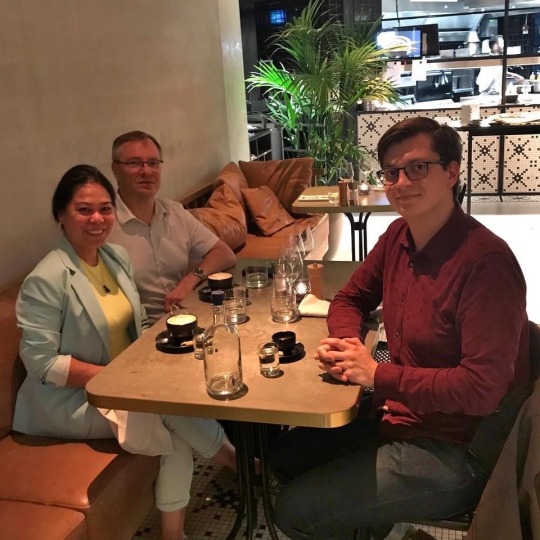

dinnerwithbren

We visited cousin Remmo en Elly Tolsma in Kortenhoef as part of my therapy.

I love ❤☕ 🥓🍳
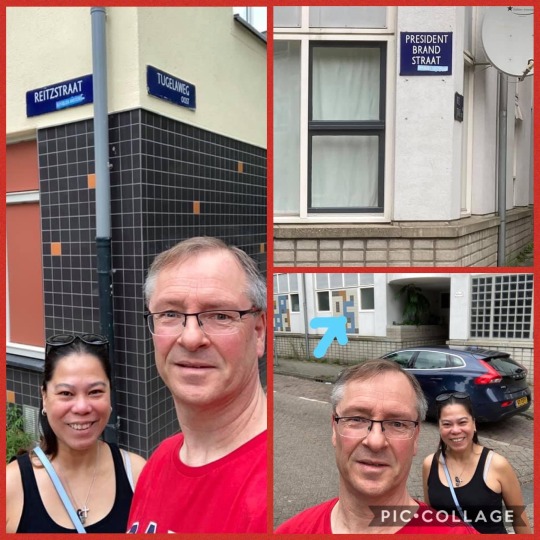
Martin’s old neighborhood
#braininjury#keeppushingforward#stroke#on the way to recovery#september 2020#QO Amsterdam#zenology#visit Remmo en Elly#longweekendgetaway#sustainable hotel#Persijn#Dutch eatery#lovebreakfast#old neighborhood Amsterdam east
1 note
·
View note
Text
Gossip Girl and Old Money vs. New Money
tldr: I broke down the family background and class status of the Archibald/Van der Bilt, Bass, Rhodes/Van der Woodsen, and Waldorf families. Because even among the 1%, old money vs. new money is still a very real difference to them.
Archibald/Van der Bilt (aka Vanderbilt) family: In the world of the show, Nate's family is presented as the oldest money of them all. His mom is a Vanderbilt (spelled Van der Bilt on the show presumably for legal reasons) a real wealthy American family. Although, among the insanely wealthy, the Vanderbilts are technically not old money. In America, old money technically refers to families who made their money prior to the Revolutionary War. Anything else is technically new money (although one anthropologist has stated starting from the 1930s on you can refer to the Vanderbilts as old money - they would just be Lower-Upper compared to an Upper-Upper family that made their money in the 1600/1700s). The Vanderbilts didn't make their money until the Gilded Age and they did it by building a shipping and railroad empire. To my knowledge, the real Vanderbilts are not a political family; the show probably took from the Kennedys there.
The Archibald family, on the other hand, are clearly not old money. I don't remember specific scenes or episodes off the top of my head, but that's implied throughout all of Anne and Howard's interactions and you can just sense it in their dynamic. I do think Howard probably still grew up rich what with Dartmouth and all (also let's be real, Anne wouldn't have married him if he wasn't), but he was probably a first gen rich boy, and I think that tracks with him going into Wall Street and investment banking instead of something more "proper". Also I think it's canon that William Van der Bilt purchased the family home and boat for them? So yeah.
Bass family: The Bass family on the other hand is as new money as they come. Bart might be evil sure, but he's truly a self-made man (or as self-made as a billionaire can be - no one earns a billion dollars without exploitation of their workers - but Bart was canonically born poor). In 107, it's established that a lot of Bart's resentment of Chuck comes from the fact that Chuck was born and raised in privilege while Bart came from nothing.
The Bass family is primarily a real estate family, owning hotels and buildings. Obviously, I have to make the most obvious family comparison here: the Trumps. The Bass family is a rival of the Trumps in the show and I think there is an obvious parallel of Bart as Fred, the shady developer who built his family fortune from the ground up using dubious methods, and Chuck as Donald, the son who earned none of what he was handed, a sexual predator, and all around asshole who ended up taking his father's company and running it into the ground multiple times. (God I'm just realizing that if Chuck was real and ran for president he'd unfortunately probably win too).
In the books I think the Bass family even owns the Plaza, just like Trump did, although this was probably changed to the Palace in the show since they were more willing to let them film regularly there.
Rhodes/Van der Woodsen family: In reality, the oldest money of them all would probably be the Van der Woodsens. Van der Woodsen is a Dutch name, and that implies that they are a family that has been in New York since it was New Amsterdam, such as the Stuyvesant, Gansevoort, Schuyler (yes like the sisters from Hamilton), and Van Cortlandt families (I believe this is the case in the books). And yes, doctors make good money, sure, but you can't afford a penthouse apartment in Manhattan on a doctor's salary, let alone yachts or private jets or anything else Serena and Eric seemed to have grown up with. I think it's safe to assume that William comes from a very wealthy family.
Now the Rhodes family on the other hand is more complicated. Cece married a record executive and moved out to California with him. However, she clearly came from an elite Upper East Side family and I think this tracks with her choosing to raise her children in Montecito, a classier, more traditional and conservative neighborhood up in Santa Barbara compared to rich Los Angeles neighborhoods such as Beverly Hills and Brentwood. (Although did she live in Los Angeles with Rick pre-divorce and only moved herself and the girls up there after the split? Unclear.)
In 113 though, Blair makes reference to the Waldorf name and reputation while disparaging Serena, implying that her and her family have a trashier reputation. So my guess is that Cece marrying a record exec and raising her kids out in California probably knocked her down a peg in Upper East Side society. Lily probably gained some of that prestige back by marrying a Van der Woodsen, but then the three divorces by the time of the pilot probably sunk them back down again.
Waldorf family: The Waldorf family is the most confusing one to decipher. The name Waldorf obviously makes you think of the Waldorf Astoria (I'm sure that's where Cecily von Ziegesar got the name from) and the Astor family, one of the Upper Upper old money families of America. Waldorf actually comes from Walldorf, the name of the town in Germany the Astors were originally from. However, the show Waldorfs seem to bear no relation to the Astors or the hotel.
Harold almost certainly came from money. He went to Yale, and I believe he was a lawyer? Which again, sure, lawyers make good money, but not Manhattan penthouse, French chateau, and private jet money. There must have been family money involved.
Eleanor, on the other hand, I'm not so sure. She seems like a self-made woman and she makes a big deal in season 2 when Blair considers not going to college and going down the Maureen van der Bilt path about how "Waldorf women are not socialites". Also it does not seem to be a big deal for her at all to marry a Jewish man (Cyrus), something that might be different if she was a true born and bred blue blood WASP.
And certainly successful fashion designers can be extremely wealthy (Ralph Lauren's net worth is estimated at 7 billion), but Waldorf Designs is clearly a much smaller company than Ralph Lauren (it's not even public). She probably has a net worth in the tens of millions, but believe it or not that's still not regular access to private jet money. Which makes me think Harold almost certainly does have family money. And again, this tracks since in 113 it's made clear that the name Waldorf means something in Upper East Side society. So my guess would be that the Waldorf family is closer to old money than new money. But still nowhere near the level of the Van der Bilts.
#did anyone ask for this? no#did i spend lots of time working on this anyway? yes#i know ive posted a lot of gg today but ive been working on this for two days and just want it out there#gossip girl#gg meta#nate archibald#chuck bass#serena van der woodsen#blair waldorf#howard archibald#anne archibald#william van der bilt#bart bass#william van der woodsen#lily van der woodsen#cece rhodes#eleanor waldorf#harold waldorf
79 notes
·
View notes
Text
In 1885, a 22-year-old Dutch woman named Johanna Bonger met Theo van Gogh, the younger brother of the artist, who was then making a name for himself as an art dealer in Paris. History knows Theo as the steadier of the van Gogh brothers, the archetypal emotional anchor, who selflessly managed Vincent's erratic path through life, but he had his share of impetuosity. He asked her to marry him after only two meetings.
Jo, as she called herself, was raised in a sober, middle-class family. Her father, the editor of a shipping newspaper that reported on things like the trade in coffee and spices from the Far East, imposed a code of propriety and emotional aloofness on his children. There is a Dutch maxim, 'The tallest nail gets hammered down,' that the Bonger family seems to have taken as gospel. Jo had set herself up in a safely unexciting career as an English teacher in Amsterdam. She wasn't inclined to impulsiveness. Besides, she was already dating somebody. She said no.
But Theo persisted. He was attractive in a soulful kind of way — a thinner, paler version of his brother. Beyond that, she had a taste for culture, a desire to be in the company of artists and intellectuals, which he could certainly provide. Eventually he won her over. In 1888, a year and a half after his proposal, she agreed to marry him. After that, a new life opened up for her. It was Paris in the belle epoque: art, theater, intellectuals, the streets of their Pigalle neighborhood raucous with cafes and brothels. Theo was not just any art dealer. He was at the forefront, specializing in the breed of young artists who were defying the stony realism imposed by the Académie des Beaux-Arts. Most dealers wouldn't touch the Impressionists, but they were Theo van Gogh's clients and heroes. And here they came, Gauguin and Pissarro and Toulouse-Lautrec, the young men of the avant-garde, marching through her life with the exotic ferocity of zoo creatures.
Jo realized that she was in the midst of a movement, that she was witnessing a change in the direction of things. At home, too, she was feeling fully alive. On their marriage night, which she described as 'blissful,' her husband thrilled her by whispering into her ear, 'Wouldn't you like to have a baby, my baby?' She was powerfully in love: with Theo, with Paris, with life.
~Russell Shorto [source]
3 notes
·
View notes
Text
Most gay Friendly Cities in the World

here are many cities round the world that welcome and embrace the lesbian, gay, bisexual and transgender (LGBT) community. These cities have actually improved and grown economically by attracting one among the foremost important and powerful social groups of the 21st century. Chains of hotels, restaurants, bars, pubs, clothes shops and spas that cater to a replacement segment that's always trying to find the simplest of the simplest . We took variety of things into consideration so as to form this text , like legal protection, social acceptance, LGBT nightlife and economic opportunities and created the list of 11 Most Gay-Friendly Cities within the World.
Toronto, Canada
11
Toronto is that the largest city in Canada and has a stimulating gay scene. it's a number of the simplest gay bars in Canada and an enormous pride parade. Toronto’s gay community offers a world of arts, culture and vivacious nightlife, with a vibrant gay village at the city’s core. The Village, located in Church-Wellesley, is that the cultural hub of the town , bursting with galleries, theatres and gay-friendly businesses. Over the years the geographical range has expanded with the expansion of the town . Now you’ll find queer-friendly establishments everywhere the town .
Where to stay: Top 11 Gay Friendly Hotels In Toronto
Toronto gay city - by Duncan Rawlinson - @thelastminute - Duncan.co :Flickr
Toronto gay city – by Duncan Rawlinson – @thelastminute – Duncan.co :Flickr
São Paulo, Brazil
10
Sao Paulo isn't only Brazil’s economic hub and therefore the largest city in South America, but it’s also the third-largest city within the world. Especially noteworthy for LGBT travelers is that the incontrovertible fact that Sao Paulo hosts the most important gay pride celebration on the earth . São Paulo’s first Gay Pride was in 1997 and attracted only 2000 people. Nowadays, the carnival-like Gay Pride Parade draws nearly four million people that crowd onto the most boulevard of Paulista Avenue and therefore the surrounding streets. Gay nightclubs feature a good sort of shows, with drag, male strip-tease, singers, performances and a few of the simplest DJs anywhere. There are many bathhouses and sex clubs too, often with bars and show nights also .
Where to stay: Top 11 Gay Friendly Hotels In Sao Paulo
Sao Paulo, Brazil 2019 - LGBTQI Pride parade of Sao Paulo Brasil 2019 - by Luciano Marques : Shutterstock.com
Sao Paulo, Brazil 2019 – LGBTQI Pride parade of Sao Paulo Brasil 2019 – by Luciano Marques : Shutterstock.com
Crossing pedestrian lights on Pride week at Paulista Avenue located in Sao Paulo , Brazil - by Jo Galvao : Shutterstock.com
Crossing pedestrian lights on Pride week at Paulista Avenue located in Sao Paulo , Brazil – by Jo Galvao : Shutterstock.com
London, UK
9
London may be a sophisticated, multicultural, open-minded city, an area where everybody is welcome. it's home to Europe’s largest gay community. Pride London may be a major event, there's a crucial Gay and Lesbian festival , and its gay nightlife is one among the world’s best. Old Compton Street and its surrounding area in SoHo is London’s gay epicenter, with gay bars and shops for each style and wish . Soho, found to the west of the West End , may be a popular spot where you’ll find many gay-owned clubs, restaurants and stores. Another similar area to see out is Old Compton Street. Another increasingly popular area is Vauxhall Village.
Where to stay: Top 11 Gay Friendly Hotels In London
Piccadilly Circus in London filled with people with flags celebrating London Gay Pride 2019 - Davi Barbiere : Shutterstock.com
Piccadilly Circus in London filled with people with flags celebrating London Gay Pride 2019 – Davi Barbiere : Shutterstock.com
Madrid, Spain
8
Madrid has the most important gay community in Spain and one among the most important in Europe, with an estimated 500,000 LGBT people living within the city. Chueca is that the center of the LGBT community where you’ll find the very best concentration of gay bars and night clubs. Chueca starts at Gran Via and runs north for 1km and it stretches east to west between Calle Hortaleza and Paseo de Recoletos. during this city, gay marriage is allowed and therefore the gay community has influenced largely the city’s trendiest hotels, restaurants and shops. Every July Madrid hosts the most important gay pride in Europe. Madrid’s gay pride, called Orgullo, draws a crowd of nearly 2 million people.
Where to stay: Top 11 Gay Friendly Hotels In Madrid
Madrid, Spain - Gay Friendly City - shutterstock
Madrid, Spain – Gay Friendly City – shutterstock
Chueca neighborhood in Madrid, decorated during gay pride day celebrations - by Victor Lafuente Alonso : Shutterstock.com
Chueca neighborhood in Madrid, decorated during gay pride day celebrations – by Victor Lafuente Alonso : Shutterstock.com
Miami, USA
7
Miami has long been referred to as a well-liked and open destination for LGBT tourists looking to unwind, work on their tans, meet people and dine at the chicest restaurants. The LGBT community has always felt welcome in Miami. All year there are beaches fashionable the gay crowd, nightclubs and venues, parties and more, but it’s the yearly Miami Beach Gay Pride Festival that brings everyone together during a colorful celebration and parade.
Where to stay: Top 11 Gay Friendly Hotels In Miami
Miami Gay Parade - by :Flickr
Miami Gay Parade – by :Flickr
Miami, Beach Party - by Olga V Kulakova : Shutterstock.com
Miami, Beach Party – by Olga V Kulakova : Shutterstock.com
Amsterdam, Netherland
6
For lesbian, gay, bisexual and transgender visitors and residents, Amsterdam is one among the foremost attractive cities in Europe. As such, it’s no small wonder that Amsterdam became so fashionable gay visitors. for hundreds of years ‘Amsterdammers’ have had a relaxed and tolerant attitude towards different lifestyles. ‘Live and let live’ is one among the city’s favorite sayings. Amsterdam is worldwide famous for its annual Canal Parade, 80 decorated boats sail along the Prinsengracht which sees the canals lined by over half 1,000,000 spectators, demonstrates and celebrates the range of Holland’s gay and lesbian community. it's the most important gay pride event within the Netherlands, and one among the most important within the world.
Where to stay: Top 11 Gay Friendly Hotels In Amsterdam
Amsterdam Canal Parade - by Kitty Terwolbeck:Flickr
Amsterdam Canal Parade – by Kitty Terwolbeck:Flickr
Barcelona, Spain
5
To this day, along side Madrid, Barcelona remains one among the foremost liberal and gay-friendly cities anywhere within the world with many Spaniards relocating from a number of the more conservative areas of the country to measure their life here to the fullest. Catalonia, the state of Spain during which Barcelona is found , has passed in 2014 an anti-homophobia law that aims to defend LGBT rights. because of this law, people physically or morally offending members of the LGBT community might be fined by up to 140,000 euros.
Where to stay: Top 11 Gay Friendly Hotels In Barcelona
Circuit Festival - by Circuit Festival Official Facebook Page
Circuit Festival – by Circuit Festival Official Facebook Page
Barcelona, Spain2019 Pride Barcelona LGTBQ Festival - by 19bProduction : Shutterstock.com
Barcelona, Spain2019 Pride Barcelona LGTBQ Festival – by 19bProduction : Shutterstock.com
San Francisco, USA
4
San Francisco is perhaps the gay capital of America. The LGBT community in San Francisco is one among the foremost important and most prominent LGBT communities within the world and is one among the most important within the history of LGBT rights and activism. for many years , the town by the Bay has been a worldwide focus for gay nightlife, culture and politics. Visitors today can explore the Castro, where it all began. Castro is one among the primary gay neighborhoods within the us . it remains one among the foremost prominent symbols of LGBT activism and events within the world. LGBT life here isn't limited to the Castro neighborhood, though that’s a tourist draw permanently reason — it’s a queer Disneyland. San Francisco is home to more nightlife than you'll shake a go-go boy at, also as vibrant bear and transexual communities. If you’re gay, likelihood is that you’ve either been to San Francisco or decide to sometime in your life.
Where to stay: Top 11 Gay Friendly Hotels In San Francisco
Castro District Rainbow Crosswalk Intersection - San Francisco , California, USA
Castro District Rainbow Crosswalk Intersection – San Francisco , California, USA
Rainbow crosswalk in Castro District in San Francisco in California USA
Rainbow crosswalk in Castro District in San Francisco in California USA
New York City, USA
3
New York is like no other city on earth. the range , the culture, the style. ny is certainly a city during a class all its own. Fashion, theatre, advertising and therefore the arts have perpetuated ny into one among the foremost gay-friendly cities within the world. Gay life is everywhere in ny City. Nightlife is vivid and overwhelming. you'll choose between endless variations on gay bars and clubs: from muscle mary clubs to cabaret piano bars, local intimate bars to modern gay lounges. In Manhattan, the gay scene is concentrated during a few neighborhoods. In Greenwich Village lays the origin of gay pride
Where to stay: Top 11 Gay Friendly Hotels In ny City
Historic Stonewall Inn gay bar in Greenwich Village Lower Manhattan - by littlenySTOCK : Shutterstock.com
Historic Stonewall Inn gay bar in Greenwich Village Lower Manhattan – by littlenySTOCK : Shutterstock.com
Big Gay frozen dessert Shop in Greenwich Village , Manhattan - by DimplePatel : Shutterstock.com
Big Gay frozen dessert Shop in Greenwich Village , Manhattan – by DimplePatel : Shutterstock.com
Berlin, Germany
2
In the 1920s (the Golden Twenties) Berlin was seen because the city with the foremost lively and advanced gay subculture in Europe. Today, Berlin sits because the gay capital of Europe. The breadth of its gay nightlife, the strength of its culture, and therefore the ever tested and changing community norms have easily eclipsed the city’s continental urban neighbors. it's just about a non-stop party, from the saunas, darkrooms, bars, clubs, cafés, festivals, balls, carnivals and celebrations a hedonist’s paradise, a sensualist’s haven, an aesthete’s delight and a raver’s Mecca, beat one package. The party scene is so diverse and innovative and celebrates any fetish! that's where the Folsom Europe fair takes place in September and therefore the Lesbian and Gay City Festival every June, Europe’s largest street party of its kind, being held within the traditional gay area around Nollendorfplatz in Schöneberg since 1993.
Where to stay: Top 11 Gay Friendly Hotels In Berlin
Berlin Folsom Fair - by lilas59:Flickr
Berlin Folsom Fair – by lilas59:Flickr
Tel Aviv, Israel
1
Right at the guts of the center East, lies a city called Tel Aviv . A bubble of sanity in an otherwise difficult and tense area. Tel Aviv, a city blessed year-round sunshine and white sandy beaches, is one among the foremost liberal cities within the world. it's the foremost gay-friendly city, not only within the Middle East but within the entire world. This vibrant city is an undisputed queer capital of the center East, It offers a 24/7 non-stop activities, all year round great weather, great food, gay beaches and infinite of gay bars and night clubs. Every June Tel Aviv is celebrating the Gay Pride week, week of celebrations and happenings throughout the town proudly Expo (Gay Culture Fair), LGBT Theater festival, LGBT festival and therefore the famous Pride Parade which is one among the foremost colorful gay parades within the world.
Where to stay: Top 11 Gay Friendly Hotels In Tel Aviv
Tel Aviv Pride Parade 2018
Tel Aviv Pride Parade 2018
Tel Aviv Pride Parade
Tel Aviv Pride Parade
Tel Aviv Beach - Jerusalem Beach
Tel Aviv Beach – Jerusalem Beach
Tel Aviv Beach Party
2 notes
·
View notes
Text
NYC Public Library - Favorite NYC History Books
The NYPL Milstein Division of United States History, Local History & Genealogy recommends our favorite, most readable, most memorable New York City nonfiction. These are the true stories of New York that engaged us, that intrigued us, and that we thought you might like to read as well.
97 Orchard: An Edible History Of Five Immigrant Families In One New York Tenement
Jane Ziegelman
Explores the culinary life that was the heart and soul of New York’s Lower East Side around the turn of the twentieth century—a city within a city, where Germans, Irish, Italians, and Eastern European Jews attempted to forge a new life. Through the experiences of five families, all of them residents of 97 Orchard Street, she takes readers on a vivid and unforgettable tour, from impossibly cramped tenement apartments down dimly lit stairwells where children played and neighbors socialized, beyond the front stoops where immigrant housewives found respite and company, and out into the hubbub of the dirty, teeming streets.
Staff says: “Food history and New York seamlessly woven together in a easy-to-read yet meticulously well researched book. I learned not only about the foods that certain immigrants ate, but how this changed over time, how Americans viewed ‘foreign’ cuisines over many different eras, and how this was a description of New York history and not just a reflection of imported appetites.”
American Passage: The History Of Ellis Island
Vincent J. Cannato
A chronicle of the landmark port of entry’s history documents its role as an execution site, immigration post, and deportation center that was profoundly shaped by evolving politics and ideologies.
Staff says: “The history of the island and the immigration station, and also of immigration policies in NY and the US. This book is well researched, scholarly and a very easy read. If you only read one book on Ellis Island, then this is it!”
The Battle For New York: The City At The Heart Of The American Revolution
Barnet Schecter
Provides a dramatic account of the seminal role played by New York City during the American Revolution, from its September 1776 fall to the British under General William Howe, through years of occupation, and beyond, interweaving illuminating profiles of the individuals on both sides of the conflict with a study of the cultural, political, social, and economic events of the eighteenth century.
Staff says:“It sticks in the mind, especially for the quality of the research and the tour of today’s New York in light of the events of history.”
The Big Oyster: History On The Half Shell
Mark Kurlansky
For centuries New York was famous for its oysters, which until the early 1900s played such a dominant a role in the city’s economy, gastronomy, and ecology that the abundant bivalves were Gotham’s most celebrated export, a staple food for the wealthy, the poor, and tourists alike, and the primary natural defense against pollution for the city’s congested waterways.
Staff says: “Lots of good NYC history in there along with the fascinating world of food history and bivalve science.”
Dark Harbor: The War For The New York Waterfront
Nathan Ward
Traces the historical influence of the Mafia on New York’s waterfront, drawing on the investigative series of New York Sun reporter Malcolm “Mike” Johnson into the region’s racketeering, violent territorial disputes, and union corruption.
Staff says: “The real story behind the film On the Waterfront. I also get annoyed when films are historically inaccurate for the sake of plot, ending, etc when the truth is probably just as exciting: see Bridge On The River Kwai. Well researched, and exciting.”
The Great Bridge: The Epic Story Of The Building Of The Brooklyn Bridge
David McCullough
Evaluates the construction of the Brooklyn Bridge as the greatest engineering triumph of its time, citing the pivotal contributions of chief engineer Washington Roebling and the technical problems and political corruption that challenged the project.
Staff says: “A favorite that everyone knows for good reason!”
Eat The City: A Tale Of The Fishers, Trappers, Hunters, Foragers, Slaughterers, Butchers, Farmers, Poultry Minders, Sugar Refiners, Cane Cutters, Beekeepers, Winemakers, And Brewers Who Built New York
Robin Shulman
Traces the experiences of New Yorkers who grow and produce food in bustling city environments, placing urban food production in a context of hundreds of years of history to explain the changing abilities of cities to feed people.
Staff says: “This interesting collection of micro histories tells the story of such New York food industries as beekeeping, fishing, urban farming, brewing, winemaking, and butchering. The author profiles people currently involved in each industry and then traces the origin, rise, usual fall, and then resurgence of that field. It was fascinating to learn about the methods of the different food industries within the unique environment of New York City.”
Five Points: The 19th-Century New York City Neighborhood That Invented Tap Dance, Stole Elections, And Became The World’s Most Notorious Slum
Tyler Anbinder
Details the notorious neighborhood that was once filled with gaming dens, bordellos, dirty streets, and tenements, that welcomed such visitors as Charles Dickens and Abraham Lincoln, and brings to light the hidden world that existed beneath the squalor—a world that invented tap dancing and hosted the prize-fight of the century.
Staff says: “An accessible and broad work looking at the notorious downtown slum’s population and sociology.”
The Island at the Center of the World: the Epic Story of Dutch Manhattan and the Forgotten Colony that Shaped America
Russell Shorto
A history of the Dutch role in the establishment of Manhattan discusses the rivalry between England and the Dutch Republic, focusing on the power struggle between Holland governor Peter Stuyvesant and politician Adriaen van der Donck that shaped New York’s culture and social freedoms.
Staff says: “The book is well-researched, the stories are well-told, and it will flesh out that point of history that most people only remember as song lyrics: 'Even old New York was once New Amsterdam…’”
Just Kids
Patti Smith
In this memoir, singer-songwriter Patti Smith shares tales of New York City: the denizens of Max’s Kansas City, the Hotel Chelsea, Scribner’s, Brentano’s and Strand bookstores and her new life in Brooklyn with a young man named Robert Mapplethorpe—the man who changed her life with his love, friendship, and genius.
Staff says: “I rather enjoyed the descriptions of Patti and Robert are discovering New York, especially Brooklyn, together. She writes prose like a poet, with detail and care and without an overabundance of imprecise words.”
Ladies And Gentlemen, The Bronx Is Burning: 1977, Baseball, Politics, And The Battle For The Soul Of A City
Jonathan Mahler
A kaleidoscopic portrait of New York City in 1977, The Bronx Is Burning is the story of two epic battles: the fight between Yankee Reggie Jackson and team manager Billy Martin, and the battle between Mario Cuomo and Ed Koch for the city’s mayorship. Buried beneath these parallel conflicts—one for the soul of baseball, the other for the soul of the city—was the subtext of race.
Staff says: “During the 1977 World Series, Howard Cosell really did say "Ladies and Gentlemen, the Bronx is burning” as flames licked up in the distance from Yankee Stadium. 1977 was the crux of the “bad ol’ days” of New York City—white flight had taken its toll; unemployment was outrageous for everyone, but close to 80% for young blacks and hispanics; infrastructure was in disrepair; crime was outrageous. This was the New York that inspired movies like “Death Wish” and “The Warriors.” NYC had bottomed out in 1977 and this is the history of that fateful year.“
Low Life: Lures and Snares of Old New York
Luc Sante
Luc Sante’s Low Life is a portrait of America’s greatest city, the riotous and anarchic breeding ground of modernity. This is not the familiar saga of mansions, avenues, and robber barons, but the messy, turbulent, often murderous story of the city’s slums; the teeming streets—scene of innumerable cons and crimes whose cramped and overcrowded housing is still a prominent feature of the cityscape.
Staff says: "This book sparked an interest in shady urban histories for me. Now that I know a lot more about the city and the context of the time frame, I even read it again. Fun, even if sensationalistic.”
Native New Yorkers: The Legacy of the Algonquin people of New York
Evan T. Pritchard
A comprehensive and fascinating account of the graceful Algonquin civilization that once flourished in the area that is now New York.
Staff says: “New York history from the Native point of view, and it will make you confront every sentimental myth you may have heard before. Everyone should read it.”
The Poisoner’s Handbook: Murder and the Birth of Forensic Medicine in Jazz Age New York
Deborah Blum
The story of how poison rocked Jazz Age New York City. A pair of forensic scientists began their trailblazing chemical detective work, fighting to end an era when untraceable poisons offered an easy path to the perfect crime.
Staff says: “Absolutely fascinating. I was surprised when I found myself at the end already. Unlike a modern forensic science drama on TV, the chemistry is all there—yet still readable and interesting. The era (late 1910s-mid 1930s) and setting are both equally captivating. So many times I thought I knew something that I clearly didn"t. This book taught me tons and still read quickly like a mystery novel, only the mysteries were all actual cases and hence more interesting than usual literary invention.”
Up in the Old Hotel
Joseph Mitchell
Saloon-keepers and street preachers, gypsies and steel-walking Mohawks, a bearded lady and a 93-year-old “seafoodetarian” who believes his specialized diet will keep him alive for another two decades. These are among the people that Joseph Mitchell immortalized in his reportage for The New Yorker and in four books—McSorley’s Wonderful Saloon, Old Mr. Flood, The Bottom of the Harbor, and Joe Gould’s Secret—that are still renowned for their precise, respectful observation, their graveyard humor, and their offhand perfection of style.
Staff says: “Mitchell, in an incredibly vivid writing style, tells the tales of some of the people he met in NYC in the '20s - '50s. The people are the history of New York.”
Source: NYPL’s Favorite NYC History Books
7 notes
·
View notes
Photo

Gardens, Courtyards, and Parks: Hidden Outdoor Spaces in the NY Metro Area
Curated by our Halstead agents
Few things are as coveted in the New York City area as green spaces. In the summertime especially, we all search for nature-filled areas to escape the noise, crowds, and pace of city life. We all know of the world-famous parks and gardens the area has to offer, but what about the lesser-known green spots—the secret gardens, hidden courtyards, and easily missed parks?
No one knows the hidden gems of New York City and its surrounding towns and cities better than our agents. So we asked them to share their favorite outdoor hideaways so that we can explore them for ourselves. Take a look at the hidden outdoor spaces they recommended, and find your new favorite place to unwind.
Palma
West Village, NYC
“On a charming single-block street tucked away in the West Village is a restaurant that understands how to do garden dining right,” Janet Weiner shares. “With farmhouse décor and flowers everywhere you are transported to a romantic trattoria in Italy.” At Palma, attention to detail resonates in everything.
“Faithful to generations of family recipes and traditions and using only organic ingredients, the food is sublime—don’t pass up the pasta! The garden in back, overflowing with flowers and roses, is not to be missed. Its retractable glass ceiling makes outdoor dining possible year round.”
Janet recommends booking a table in the private carriage house for an intimate dinner party, while reserving the garden for a more festive event like an engagement or birthday party. “Dining in the garden at Palma is like taking a weekend getaway in the Italian countryside without leaving New York.”
Recommended by Janet Weiner of our Village office
Half-Moon Overlook
Spuyten Duyvil, The Bronx
An intimate space on Palisade Avenue in Spuyten Duyvil, Half-Moon Overlook faces west and gives you a view of where the Hudson and Harlem Rivers meet. The small park is named for Henry Hudson's ship, the Halve Maen, and it is a beautiful perch to watch the sunset from and forget you're in a big city.
Recommended by the Sanjya Tidke Team of our Riverdale office
The Maidstone
East Hampton, NY
The Maidstone has cozy fireplaces and a great bar inside, but it also has a beautiful garden where you can enjoy a drink or a meal. With umbrella-covered tables, benches, and plenty of greenery dotting the area, the garden is a great place to enjoy a friend’s company or sip on drinks with a larger group.
Shaded by large trees, there is a peaceful, almost park-like atmosphere here. “The grounds are absolutely beautiful,” Ani Antreasyan says. “And as a landscape designer, it’s one of my favorite places to hang out in East Hampton.”
Recommended by Ani Antreasyan of our East Hampton office
Amster Yard
Turtle Bay, NYC
Tucked behind Instituto Cervantes, the Spanish Cultural Institute, Amster Yard is a true hidden gem. Vivian Ducat goes to this courtyard refuge to work sometimes and enjoys the Victorian atmosphere, with its iron grille work, wrought-iron chairs, and beautiful greenery.
Recommended by Vivian Ducat of our Harlem office
Rowayton Community Center Courtyard
Rowayton, Connecticut
The land where Rowayton Library sits has a long and interesting history. Built over 100 years ago, the building that now contains the library used to be a barn and is on the National Register of Historic Places.
Mike Barbis, who is a Commissioner for the town, shares the beauty of the barn's courtyard. It was renovated a few years ago and includes café chairs and tables where you can read or simply enjoy your surroundings. There's even a 100-year-old English Yew. On the property you can also find the dog park and the greenhouse, known as the Potting Shed.
Recommended by Mike Barbis of our Darien office
Tudor City Greens
Tudor City, NYC
Two elevated spaces above 42nd Street and First Avenue offer a breath of fresh, quiet air above the maddening crowds below. The gardens are maintained by a neighborhood non-profit and boast much-needed shade, flower beds, benches, and gorgeous views.
Recommended by Madeleine Dale of our West Side office
Mount Prospect Park
Prospect Heights, Brooklyn
A little-known park nestled between the Brooklyn Botanic Garden and the Central Library, Mount Prospect Park contains the second highest point in all of Brooklyn and was used as a lookout point during the Revolutionary War. The park is now frequented by locals and their dogs for early-morning playtime. It's close to Kris Sylvester's home, so he often goes there with his daughter so that she can practice riding her bicycle.
Recommended by Kris Sylvester of our Village office
West Side Community Garden
Upper West Side, NYC
Amelia Gewirtz was on her way to a friend's house when she heard jazz coming from a flower-filled area on 89th Street. She had happened upon the West Side Community Garden, hidden between Amsterdam and Columbus Avenues. Since then, the serene hideaway has become Amelia's favorite hidden garden, not only because of its stunning atmosphere, but also because of the many free music and theater events that are hosted there.
Recommended by Amelia Gewirtz of our West Side office
Terrain Garden Cafe
Westport, Connecticut
Terrain's greenhouse cafe has beautiful décor and seasonal menus, and there is an outdoor section as well. Enjoy a peaceful meal here surrounded by the lush greenery.
Recommended by Alison Mark of our Westport office
St. Luke's Garden
West Village, NYC
A green oasis in the West Village, the garden belonging to The Church of St. Luke in the Fields is a home for flowers, berries, birds, and butterflies. This is where Bo Poulsen used to have lunch, and though it's in plain sight, it's not nearly as visited as you would think.
Recommended by Bo Poulsen of our Village office
The Elevated Acre
Financial District, NYC
Take the escalator at 55 Water Street to discover an expansive urban oasis above the bustle of the Financial District. Here you will find landscaped gardens, a lawn, winding paths, a beer garden, and an amphitheater. The views are pretty incredible, too.
Recommended by Madeleine Dale of our West Side office
Paerdegat Park
East Flatbush, Brooklyn
Found in a part of Brooklyn with a lack of green spaces, Paerdegat Park offers a full recreation center including basketball and handball courts, a playground, benches, and most importantly, trees.
Recommended by Wilford Nelson of our Fort Greene office
New Canaan’s Protected Lands
New Canaan, Connecticut
The New Canaan Land Trust owns over 350 acres of land across the town in an effort to conserve the spaces. Included are the Bristow Bird Sanctuary, Watson-Symington Woodlands, Browne Preserve, and Silvermine Fowler Preserve. Found dotted around the town, these areas have diverse terrains and feature rivers, meadows, reservoirs, and wildlife.
Recommended by John Engel of our New Canaan office
Greenacre Park
Turtle Bay, NYC
A beautiful urban green space nestled between Second and Third Avenues on 51st Street, Greenacre Park is a serene escape from the bustle of the city. It features a 25-foot-high waterfall flowing down a granite wall, a rarity in New York City. “It’s truly a hidden gem,” Ali Rubenstein says.
“Mature trees and landscaping fill the space to create a jungle-like atmosphere with tables and chairs sprinkled throughout. It’s a few blocks away from my apartment, so I frequent this tranquil oasis on the weekends in the spring and summer to enjoy my morning coffee. I always leave feeling refreshed and at peace.”
Recommended by Ali Rubenstein of our Brand Team
Liz Christy Community Garden
The Bowery, NYC
The oldest community garden in New York City, this green space was established by Liz Christy and a group of “green guerrillas” that cleaned up and beautified the then vacant lot. Today, you can find a pond, wildflower habitat, weeping birch trees, vegetable gardens, a grape arbor, and more.
Recommended by Madeleine Dale of our West Side office
Columbia Manhattanville Courtyard
Manhattanville, NYC
Vivian Ducat was searching for a comfortable outdoor space to relax, so she headed to Columbia University’s Manhattanville campus. She walked alongside the Jerome L. Greene Science Center and came upon a lovely courtyard with shade-providing trees and colorful chairs and benches. “A breeze off the river makes it a very pleasant place to sit,” Vivian says.
Recommended by Vivian Ducat of our Harlem office
Public Hotel Garden
Lower East Side, NYC
The Public Hotel has the popular Bowery Garden on its rooftop, but for a more casual atmosphere, try the small garden directly in front of the building on Chrystie Street. The space has picnic tables for you to enjoy a meal (consider getting something from the Jean-Georges food bar inside) and have a nice respite from the city.
Recommended by Bo Poulsen of our Village office
2 notes
·
View notes
Text
Going Real Estate Shopping in a Climate Change-Threatened Miami
Sarah Miller went looking for real estate in Miami, a place where the sea level could rise between one and three feet in the next 30 years. As she discovered, the real estate agents there have gotten good at deflecting buyers' concerns about such matters.
I asked how the flooding was.
"There are pump stations everywhere, and the roads were raised," he said. "So that's all been fixed."
"Fixed," I said. "Wow. Amazing."
I asked how the hurricanes were.
He said that because the hurricanes came from the tropics, from the south and this was the west side of Miami Beach, they were not that bad in this neighborhood. "Oh, right," I said, as if that made any sense.
I asked him if he liked it here. "I love it," he said. "It is one of the most thriving cities in the country, it's growing rapidly." He pointed to a row of buildings in a neighborhood called Edgewater that were all just three years old. "That skyline was all built in the last three years."
Wow, I said, just in the last three years... "They're not worried about sea level rise?"
"It's definitely something the city is trying to combat. They are fighting it, by raising everything. But so far, it hasn't been an issue."
I couldn't wait to steal this line, slightly altered. "I am afraid of dying, sure, but so far, it hasn't been an issue."
Later, I texted Kristina Hill, an associate professor of urban ecology at the University of California, Berkeley, whose main work is helping coastal communities adapt to climate change. I told her that a real estate agent had just told me hurricanes were weaker near Sunset Harbour, because it was in the east side of Miami, and hurricanes come from the south. She wrote back, "That's ridiculous!"
The analysis of why Amsterdam and Miami are quite dissimilar when it comes to their respective responses to climate change is enlightening.
The Big Plan in the Netherlands depends on walls. Since Miami is built on limestone, which soaks up water like a sponge, walls are not very useful. In Miami, sea water will just go under a wall, like a salty ghost.
7 notes
·
View notes
Text
Missing Pieces, part 6
Welcome back. When last you were here, Day got all schmoopy. Onward.
So, Denny’s happened. Later, we agreed that eating at Denny’s at 8:00 p.m. was somehow less respectable than eating at Denny’s at midnight. But it was a long day and we all could stand to have some greasy comfort food. We all decided to head home, get an early night’s sleep, and then head out to Schenectady in the morning to check out the beer hall. Bella decided to stay over at Pam’s place, letting Duke Lamington know where she was, and everybody else went back to their places. I spent a solid 25 minutes giving Adrian index card updates via Paisley.
As I was about getting ready to go to bed, I noticed a quick flash from across the street. Upstairs, Yova noticed it, too, and we both looked out the window to see a jalopy. Yova quickly got dressed and dashed downstairs, while I was able to see a pretty big guy – not big in the Day or Nash sense, but a heavyweight human man – jump into a car and drive away. It was a beat-up old sedan that looked about as functional as Yova’s crappy pickup. Around this time, I heard banging at the door. When I checked to see who it was, Yova was on the other side. We quickly confirmed with each other that we’d seen what we saw and we quickly decided to get the others and have them bunk in our building for the night. She drove off to get Pam and Bella.
Around this time, Pam heard the banging of a jalopy coming down the street. She went to take a look and saw a figure hop out of the driver’s side of the car. She opened her window and called out, asking him if he needed any help. He was pretty taken aback and stammered out some explanation. “Well, you know, you should get your muffler examined, because there are noise regulations around here,” Pam said. Facing the full fury of the Parent-Teacher Association, the dude took a solid minute to come up with something else to say, but before he could, there was the sound of another car coming. The guy hopped back in and peeled out, but not before Yova was able to snap a picture of his license plate. She got out, hurried up to Pam’s door and explained what we saw. Pam and Bella each packed an overnight bag to come stay with us. On the way back, they picked up Day, who was disgruntled and unhappy and even less talkative than usual.
Yova and I each gave up our beds for the evening so our guests could have them. In Yova’s case, it was because her couch was long enough for her to sleep on comfortably and Pam and Bella were small enough to share her bed. In mine, it was because I felt my bed was more structurally sound than my couch as far as supporting Day. Before we went to bed, Day said that we should try to make a visit to the DMV in the morning to try and track the license plate down.
We all hunkered down for the night and four of the five of us got some sleep. I’d like to say that I was one of them, but the chainsaw noises coming from my room couldn’t be drowned out, no matter how many pillows I pressed against my ears. The next morning, Day was bright-eyed and bushy tailed, coming out of my room and asking what was for breakfast. I pushed myself up to a sitting position and said, “You know, the first eight times or so, I thought that it was just head-on collisions between tractor-trailers on the street outside. How much freaking coke did you snort to fuck up your septum that badly?” “It wasn’t coke, it’s sleep apnea! And I had a rough day, I needed some me time!” he retorted. After a few moments of dead silence, I managed to get out, “That lotion is for my feet. Not. Nefarious. Purposes.” “And yet, it smells like lilacs,” Day said. I got off the couch, stomped over to the fridge and slapped a box of Eggos on the counter. “All right! You got peanut butter and jelly, too?” he asked. I pointed to the pantry and fridge and went off to take a shower.
Upstairs, Yova was about to go out and start her morning workout routine, only to discover that Pam was up early and had already made breakfast for her, some Russian dish involving almost-stale bread. Yova told me later that it was something her mom used to make, which stopped her dead in her tracks from going to the gym. Day went upstairs for second breakfast and Pam whipped up some eggs and bacon for him and some blueberry pancakes for Bella. I spent a solid twenty minutes cleaning up the mess in my kitchen before I met the rest of them downstairs.
We hightailed it over to the Albany County DMV. Thankfully, we got there early enough to where there wasn’t too long of a wait. A Mrs. Pepperpot type person called Day up to her window. They bantered for a minute with Day first trying to be friendly (it worked about as well as you think it did), and then leaned on her with the bad-cop routine. She rolled her eyes and finally agreed to enter the license number, at which point her eyebrow raised. She leaned on her elbows and told Day, “I really don’t have time to deal with some guy’s bullshit today. The queue isn’t going to get any shorter and my lunch break is four hours off. I’ll throw you a bone, just get out of here and let me do my job. Now, I could tell you who owns the vehicle, but it’s not going to do you much good, because this vehicle was reported stolen two weeks ago.” He asked her where it was stolen from and she told him it was from a neighborhood up in Amsterdam, about thirty minutes east.
While they were going on about this, I sat in the waiting area, completely traumatized and telling the others about the mess that was left. “He snored like a drunk grizzly,” I said. “Well, that’s not something he could control,” Pam said. “He dragged the Eggos through my peanut butter and jelly,” I said. “I mean, in terms of sins, that’s not a mortal one,” Yova said. Then I looked up at them and said, “And you don’t even want to know what I found in the wastebasket next to my bed.” That led to dead silence. “That bottle of lotion was three quarters full yesterday. Now it’s half full,” I said. “Oh. We’re going to have to get rid of your bed now,” Bella said.
Day came back over with the information he’d gotten and we traipsed out to Amsterdam, me giving the thousand-yard stare all the while. When we pulled up to the street where the car had been taken from, we realized that it wasn’t exactly an affluent neighborhood, but certainly not a bad part of town. It kind of reminded me of the working class neighborhood I grew up in. Day, unwisely, decided to take the lead on the investigation and scouted around, looking for someone to ask for info.
Eventually, he spotted a pair of hausfraus having a chat over their fences and he went up to talk to them. From the sight of their faces, it was obvious they had absolutely no idea what to say to the giant of a man standing before them, but eventually one of them greeted him. He started asking questions about the missing car, telling them he was a PI, and trying to be friendly. I don’t mean to drag the guy (too much) but friendly isn’t exactly his strong suit. They were not interested in the conversation at all, but one of them did let slip that there was another PI asking around about the same thing, a woman. “I think you should probably go talk to the police,” one of them said, and then they turned back to each other and continued their conversation. Yep. He got Karened.
Fortunately for our investigation, we had a secret weapon of our own: a fully-fledged by-God member of the Parent-Teacher Association. While Day sulked in the car, Pam walked up a few minutes later, asking the women if she could talk to them about the local school district and how her family was planning to move to the area. They were much more receptive to Pam and they started telling her each and every gossip about the area. When Pam asked about crime, they said that the neighborhood was usually pretty safe, except for the strange car robbery a couple of weeks past. Pam managed to out-Karen the Karens as she led them into conversation, learning about how nobody was that sorry to see Mr. Jeffers’s car go because it was a real piece of junk. They stage-whispered to her about how they wondered if there was a possibility of drugs and whether Mr. Jeffers might have smoked five whole marijuanas.
Once we knew whose car had been stolen, we dropped Day and Bella off to talk to Mr. Jeffers while the other three of us went to go talk to the po-po. Day started asking Mr. Jeffers questions using the same techniques that got him nowhere with the Karens and Bella mercifully interrupted, turning out the cutesy act, batting her eyes, and asking Mr. Jeffers if they could get some info from him to help find his car. He was disarmed and agreed to tell them what he knew, what wasn’t much. He wasn’t all that upset that the car was stolen – the insurance company was already processing a claim and he was going to get a better car out of the deal. He was able to tell them that there were a ton of cigarette butts all over his driveway, but aside from that, he didn’t see anything because he wasn’t home when the car was stolen.
Pam, Yova, and I went to the police station, which was pretty small, only covering a couple of neighborhoods. Yova took the lead with the receptionist, telling her she needed to make a report with a detective about a man taking pictures of her through her apartment window (not, technically, a lie). The officer came out and Yova gave him her report, but gave him a phony address from nearby. When she gave him the info for the car, he mentions that an Albany PD officer came through, asking about the same info. Yova asked for her contact info and he gave her card. The officer’s name was Brenda Break. When Yova tried to call, the voice mailbox was full, so we decided to swing by the precinct on our way back to Albany.
“So, Brenda Break,” I said when we got back in the car. “Her parents must have hated her.” “I wonder what her middle name is?” Pam asked. “Probably Beatrix. Brenda Beatrix Break,” I said. “Ooh. Or Bethany. Brenda Bethany Break,” Yova said. “Brenda Bridget Break?” Pam asked. “Brenda Barbie Break?” I asked. “Brenda Brianna Break?” Yova asked. “Brenda Belinda Break?” I asked.
You get the picture. Point is, we were still coming up with middle names for her when we picked Day and Bella up. He looked kind of – surprised? Taken aback? – when he heard what we were saying and we explained that we were trying to figure out what the middle name of the officer from Albany PD who was looking into the car was. He went pale when we said we were going to go speak with her and started stammering out some obvious lies about why he couldn’t come along. We saw right through that and asked him what was up. He let out a long sigh and came clean about it: Brenda was his old partner on the force, someone who he didn’t always get along with but who he had a mutual respect for.
It was at this point that Yova had a horrible realization and she turned to me. “Derek, didn’t you say the guy who you saw out your window was on the heavier side?” “Yeah,” I said. “Bigger dude, not like Day, but hu – ohhhhhhhhhhh,” I said, realization dawning on me as well. “What? What is it?” Day asked. Yova and I looked at each other, then at him. “Day… do you think maybe the guy who stole this car was…” “Was who?” he asked. “Your Fetch,” Yova and I said in unison. He slumped against the side of the car. “And maybe that’s why Brenda’s looking into it, because she thinks it’s you?” Yova asked. Day didn’t have much to say to that. “Listen, if you want, we can drop you off back at your apartment. You don’t have to come see her if you don’t want,” Pam said. Day took a minute to respond, then nodded, saying that he’d rather not. We dropped him at his place and agreed we’d pick him up when it was time to go to Schenectady.
As we pulled away from his apartment, I said, “Okay, I wasn’t going to say it when he was in the car, but were they seriously Day and Break?” “You see, I was thinking that, too…” Yova trailed off. “I mean, it could have been worse,” I said. “She could have been Nancy Night.” And with that, we drove off to speak to the po-po for the second time that day.
Albany PD was considerably bigger and busier than the Amsterdam PD. There was a secretary at the front desk who somehow managed to look both stressed and bored at the same time. Yova took lead as usual and asked him about Officer Break, saying that she had information about a case she was handling. He agreed to go get her and disappeared down the hall. When Brenda came down the hall, I was surprised to see she was much younger than I was expecting, and attractive. Kind of like a battle-hardened, corn-fed Emma Stone.
When she saw us, she stopped in her tracks and told the secretary that she was going to step out for a few minutes. She asked us what information we had for her and Yova gave her the cliffs notes. Brenda held the door for us and led us down the hall to an out-of-the-way room. Once she got us down the hall, she started acting positively giddy, saying, “Oh, man, this is so great. I’ve been trying to talk to some of you guys for so long, and you always run from me. But now you’re here! This is great! This is awesome!” The four of us looked at each other, clearly not understanding. But then she started dropping hints that she could see what we really are.
“Wait, so… what do you see me as?” Yova asked. “You’ve got this crazy bright hair and eyes, it looks like starlight and nebulas,” Brenda said. Yova pointed at me and said, “And does he have feathers?” “Oh, yeah. A shit-ton of feathers,” Brenda said. I bristled a little at this and said, “I don’t have that many feathers…” Brenda told us that a little more than two years ago, she’d suddenly started being able to see changelings (she obviously didn’t know what we were, but from what she was describing, it was clearly changelings).
I asked her when she was able to start seeing us, and if it was around May 2015. “A little later than that,” she said. “I had this partner – big, gruff guy. And he used to wear the most godawful aftershave. Smelled horrible. He disappeared and… this one day, I would swear I could smell that aftershave. I went out my front door, smelling it. Only it wasn’t my front yard. It was this weird brambly maze, I didn’t recognize it. But I kept going after that scent.”
She told us that eventually she made her way through the Hedge (not that she knew it was the Hedge) and found her way out at a Little League field a few minutes from her house. And ever since then, she was able to see things that she hadn’t before. This, as you might guess, left us all completely nonplussed. She wasn’t threatening or anything – she seemed completely thrilled to be talking to some of us. “You have to understand, we’re a skittish lot,” Yova told her. “If someone we don’t recognize comes running full on at us, our first instinct is to bolt.”
Brenda wanted to talk with us at length about what we were. As much as we realized we probably had to do this, none of us were comfortable to keep going with that conversation in the precinct. She told us that she had a lunch break coming up and we agreed to meet with her at a nearby restaurant.
And that’ll about do it for this week’s installment. Next time: brunch with Brenda! And other shenanigans. Until then, be safe, and may you always keep your Bath & Body Works under lock and key.
1 note
·
View note
Text
Alps 2019
(Written by Arthur Scopic - March 29, 2019)
Landing Zurich
****
On landing at Amsterdams Schipol, I knew something wasn't right, not just the usual transatlantic blear, but odd chills and fever. Texting my pal Subtle Plague, I warned him that I may have a cold or flu and may be infectious. He dismissed any concerns, citing their own little germ trawler as being of greater
potential for flus or colds and nobly insisted we meet.
So, after nearly missing the connection to ZRH due to customs clogging at Schipol, I boarded the flight to Zurich, dozed some more in that jetlag timewarp and embarked on the train for Konstanz from ZRH.
Konstanz, Subtle Plague
****
Subtle Plague met me at the train station and ferried me to his house to meet his family and set me up for a nap before we headed out to the Gotthard zones. I considered just taking a hotel and convalescing but hope sprang eternal in my skiersoul, so next morning we headed out on the Swiss highways to the
Gotthard tunnel and Airolo.
Konstanz

It was over twenty years ago that I landed in Geneva and contracted a cold and rather than taking it easy, jumped into skiing around La Grave, Serre Chevalier, Puy St. Vincent and the Milky Way. But by the 6th day or so, while skiing at Val Thorens, I knew something was seriously wrong. I shortly spiraled into
fill blown pneumonia, eventually requiring IV antibiotics on returning to the US.
Airolo
****

So this time, I was going to be smarter and on arriving at Airolo, despite the pow and sunshine, I deferred on the skiing and snoozed in Subtle Plagues RV. I took solace in the fact that one of the more widely read ski weather forecasters had explicitly directed his followers to Airolo, resulting in crowding
and pow frenzy that chewed up the snow at what is normally a low key area. Such is the internet.
At days end, we drove up a nearby valley and camped out for what ended up being one of the most fevered nights I'd ever had. My throat burned on every swallow and my head throbbed with a thundersome sinus headache resulting in little sleep. So once again, skiing that day was not for me. Subtle Plague was a
prince about it all, understanding and left me to me convalescing.
Konstanz Again
****
At days end after Subtle and buddies had enjoyed a powdery tour, we rolled back to Konstanz in the RV. Konstanz is a beautiful town, with it's older buildings and neighborhoods having escaped some of the ravages of WWII by virtue of being on the Swiss border and thereby not targetted by bombing raids. I knew that Subtle and family had a busy Monday morning ahead of them so after sleeping Saturday night and being feasted and feted by their hospitality, I trundeled off in a train headed to St. Anton Sunday afternoon.
St. Anton, Haus Elisabeth, Arlberg Guides, Verwall, Hinterrendl
****
I had initially planned to roll out East to the Gasteinertal and ski that zone, but the flu caused to me to reevaluate that plan. I wrote the wonderful folks at Hotel Echo Bad Gastein and cancelled my room there and dredged around for another option in St. Anton when I found Das-Elisabeth which fit my requirements of being reasonably close to the train station. So I booked a room there. It proved to be an excellent choice with a superb breakfast and quiet spot to finish this flu. I again chose not to ski the first day, but with a suggestion from the host, Berthe, found a doctor to check me out and write a script for the antibiotics I knew I'd need after this flu. I walked around the village in a howler
snowstorm, got a good sleep and readied myself for the first turns of the trip.
St. Anton is HUGE and I not knowing it at all, I opted to try to find some guided options. The best deal I found was with the Arlberg-Guides who offered a guided group option for 97Euros. This turned out not only a great option, but fortuitous as well by virtue of meeting Sebastyn.
The lift system is staggering with a base terminal at the Galzigbahn looking like a spaceship.

The day broke blue and crowds were massive with enormous lines at the Galzigbahn. Our guide circumnavigated that queue, opting for the Gampenbahn chair for a checkout run before taking us down into Schongraben for
some quality pow.
Next up, we rode up into the Galzig zone, hoping to get up into the Schindlerspitz. But due to avalanche levels being up to 4, both the Schindlergrabahn and the Valuga were closed. On traversing out towards the
Arlberg Pass, we could see a gargantuan liftline at the Arlenmaderbahn, so we took a high traverse to access the Albonabahn II.
View from Albonabahn II

After a few laps down that we skied the North face down into Stuben and used the old Albonabahn chair to get back to the Albonabahn II and started down into a beautiful valley ending the day in Verwall with beer and local game charcuterie.
****************************************************************************************************
I found a sign for a museum that turned out to be a beautiful old chalet that was a combination ski museum and restaurant, so I went in for a light dinner.

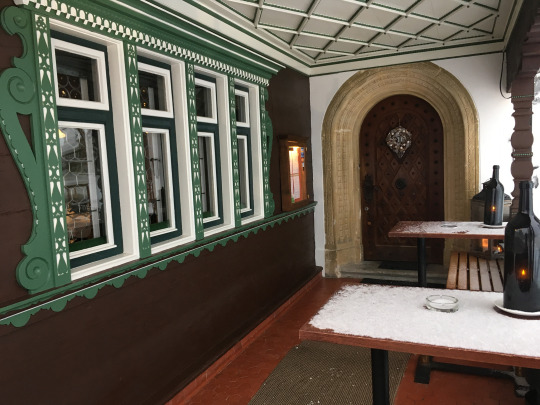



Karl Schranz's Kneissl White Stars

Next day, another storm had moved in, so I elected to repeat with Arlberg Guides and again skied with Sebastyn, a sharp wit and keen skier who had grown up skiing in the Arlberg. We had a different guide who, after a warm up on the Gampenbahn, took us over to the North facing Rendelbahn zone. After riding several lifts we dropped over into Hinterrendl, a spectacular bowl of excellent powder with views obscured by storm.
Old door in St. Anton

The day after, it was still storming but I wanted to have a little more free reign, so I elected to skip the Arlberg Guides. I had also moved hotels to the Hotel Kirchplatz which was a bit East of the town center and closer to the Nassereinbahn where I started the day. Lo and behold, there was Sebastyn who kindly offered to ski with me that day. After a couple of runs, we hooked up with his friend Victoria and spent a few laps skiing the powder in what I'll call the Galzig Gullies near the Osthangbahn chair. It was light, thigh deep snow in among the trees with decent visibility. After a bit, Vicki suggested that we meet up with her boyfriend Yannick who was to get off guide duty at noon, so we skied back down to the Nasserein base. Yannick got off and suggested another lap down the powder in Schongraben. While chatted on the lifts as we sampled snow over in the Galzig zone, we found that Victoria's mom is Berthe who manages Haus Elisabeth. The Freakwhency strikes again! We ended the day with beer and wienerschitzer at the Krazy Kangaroo around 3:00. A big thanks to Seb, Vicki and Yannick!
View from Hotel Kirchplatz
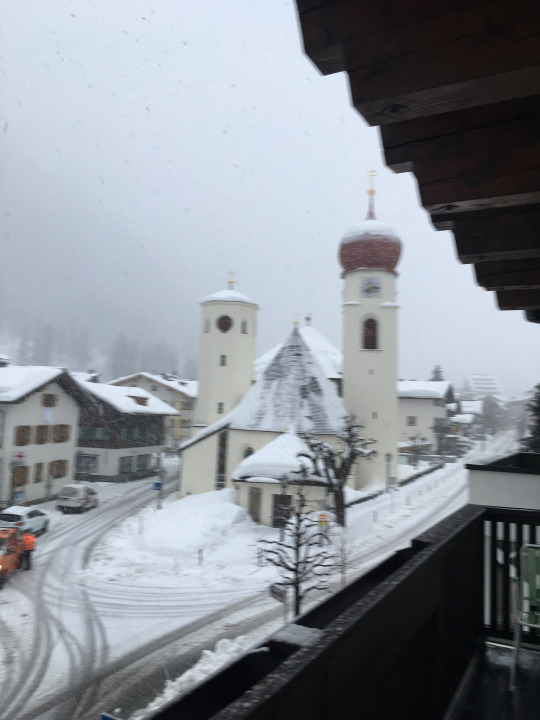
Old St. Anton chalet
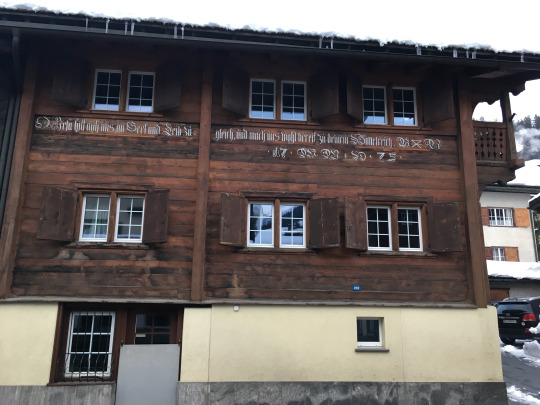
The next day, Friday, was my last day in the Arlberg and it was forecast to dump with rising freezing levels. Sebastyn had to head back to school, so I decided just to roll solo around the Galzig Gullies and whatever else was visible. This proved to be not much. The day started with spooky snow fractures in the trees around the gullies, but failed to actually slide on the ski cuts I put in. So I raged solo mad laps mostly on the Galzigbahn until about 1:00 when it started to rain at the bottom. By 2:00 I was soaked, so I headed back to the Hotel Kirchplatz to wash and dry stuff. It's a great hotel with a sauna, wellness spa and free washer and dryer which I sorely needed. By 3:30 I was at the bahnhof and by 4:00, rolling to Klosters.
I can see why the Arlberg is so popular: it's massive and gets a lot of snow. At the same time, it's crowded and lots of the businesses in town are jaded by tourists. I was extremely lucky to hook up with Sebastyn, Victoria and Yannick who were incredibly warm and abundant and convinced me that my aversion to St. Anton as an instance of a megaresort, was ill founded. I'll be back.
****************************************************************************************************
Klosters, Hotel Wynegg, bw_wp_hedonism, Gargellan, St. Antonien
****
After a 3.5 hour jaunt on Austrian and Swiss trains, I stepped onto the platform in Klosters Platz, right next to the soaring Gotschnabahn tram. I had been in touch with bw_wp_hedonism who had generously offered to meet up. I had also dug around for a reasonably priced room, a somewhat rare beast in Klosters and had stumbled across Wynegg, a recently revamped old hotel which was establishing itself as a haute gourmando locus. So I booked a room there, a 10 minute walk from the bahnhof. bw_wp_hedonism pinged me via whatsapp and turned up in the hotel bar. We made plans for the next day to poke around Parsenn, one of 5 enormous lift systems in the Davos/Klosters complex.
I was a little late and with blue sky and fresh pow, the lines at the Gotschnabahn were significant. bw_wp_hedonism had waited and we ran into his buddy Tom and were off. We raged all over the Parsenn, up to the summit via the Furka lifts and then the Gipfelbahn where we found sweet deep untracked snow on a variety of North facing exposures.
View from Schiferbahn gondola
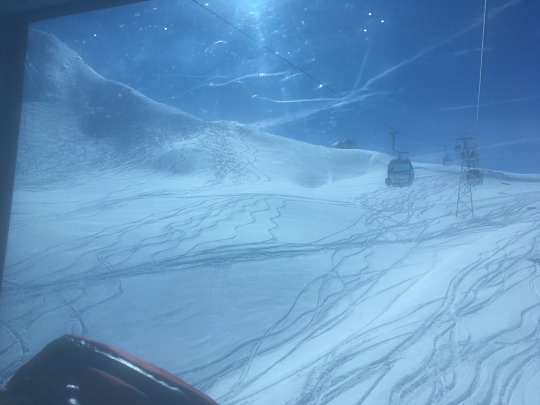
The area is laced with dozens of groomers that keep lots of tourists busy and provided access to an innumerable wad of excellent off piste options. After a couple of laps on the Schiferbahn in excellent pow, we met with a bunch of bw_wp_hedonism at the midmountain near the base of the Furka lift for
lunch. After a lengthy lunch we made a few more sidecountry laps by taking bootpacks and traverses off the Totalp zone, eventually making apres ski at Berghaus Schifer.
View from midmountain Parsenn, untapped offpiste above

I rolled back to the Wynegg for a shower and nap before taking a table in the restaurant at 8:30.
The food was superb, starting with an excellent salad, I ordered a soup that was celestial: a foamed saffron broth and perfectly poached prawns. The wine list was fantastic with a crisp chardonnay and an excellent local, rich pinot noir by the glass. I finished with the specialty pizokel noodle and lamb in a deliciously deft creamed curry sauce. I zonked out by 22:00.

bw_wp_hedonism had referred to doing a tour I had eyeballed for years, one that went over a little pass above the Madrisa area over into the Voralberg and the Gargellen ski area, then back over to Switzerland and the tiny medieval town of St. Antonien.
****************************************************************************************************
On waking, we texted back and forth making plans to meet at the top of the Madrisabahn and head out. And so we did. It was amazing with an easy, gently ascending skin S/SE from the top of the Schaffugli lift to the Schlappiner Joch and the border with Austria.
Looking south from Madrisa
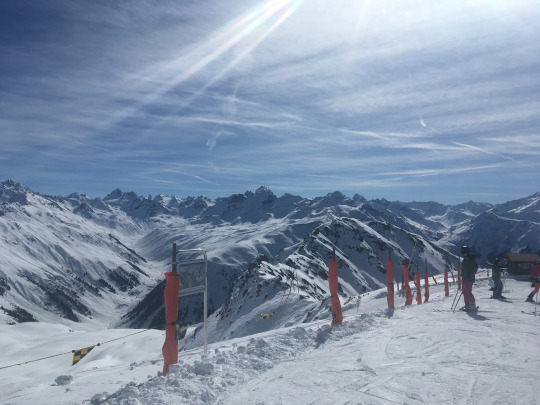
On the skintrack to Schlappiner Joch. Schlappiner where?
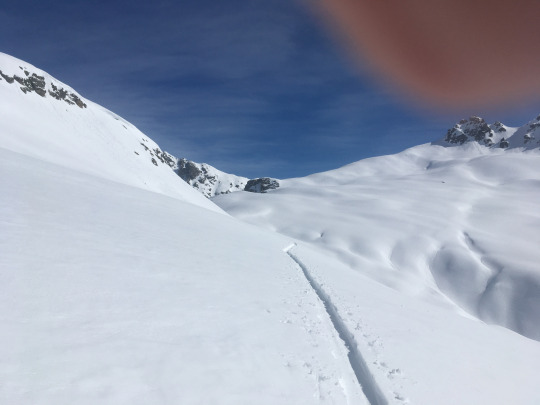
At Schlappiner Joch
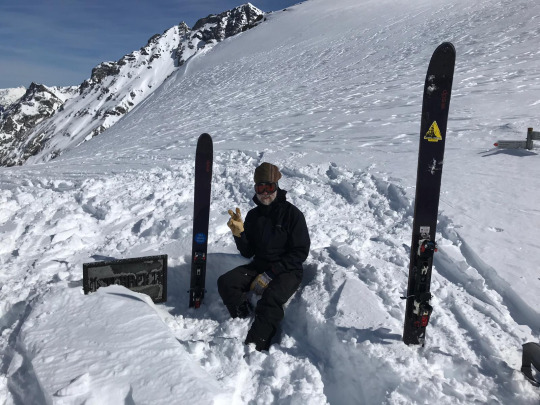
The ski down from there was on beautiful sparsely tracked North facing steep slopes with a long and easy run out down to Gargellen where we had to stop in at the base of the gondola to get single ride passes back up to the top of the Kristelbahn and a slightly more significant climb up to the Sankt Antonier Joch.
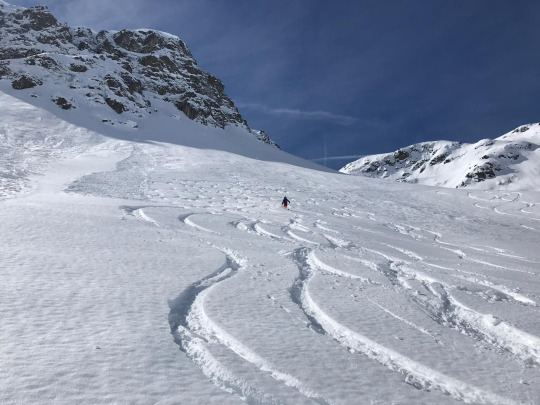
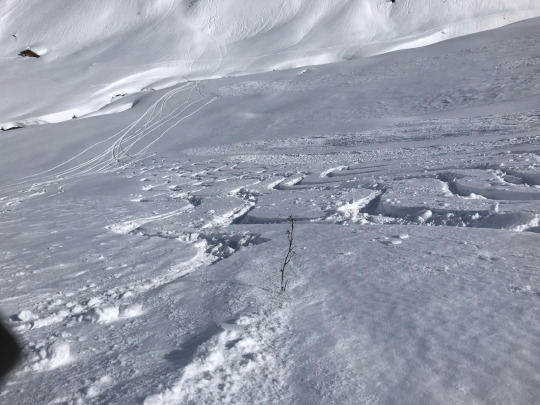
From there. it was a West/Northwest facing series of virgin pow lines draining
down into a creek gully which fed us out onto a road requiring the canonical walk in ski boots down into the atmospheric town of St. Antonien clustered around a spike steepled church dated 1492. There we enjoyed beer and charcuterie until the bus came and we wound around curves connecting ancient villages down to the train station at Kublis.



St. Antonien


At the Kublis bahnhof, I thanked bw_wp_hedonism and pal Tom for their gracious abundance, I had had an amazing time around Davos, again, more data that eroded my reluctance to ski at the more reknown areas.
I rallied back to Klosters and the Hotel Wynegg, extending my sincere thanks to Cedric and all the folks who run an incredibly warm and tasteful hotel to which I hope to return. Grabbing my clothes and gear, I hopped the train for Rueras, Switzerland to meet up with the motley band of maggots at MtLodge
****************************************************************************************************
Rueras, MtLodge
****
The train actually ended in Disentis with the last leg of the trip to Rueras in the trusty Swiss postbus which kindly dropped me at the very door to the hotel. There I met the owner, Michele, an effusive and warm persona who set me up with a sweet room and delicious food and drink. He had also queued up a number of routes and tours that I had ogled for years. But first, sleep. It was dumping.
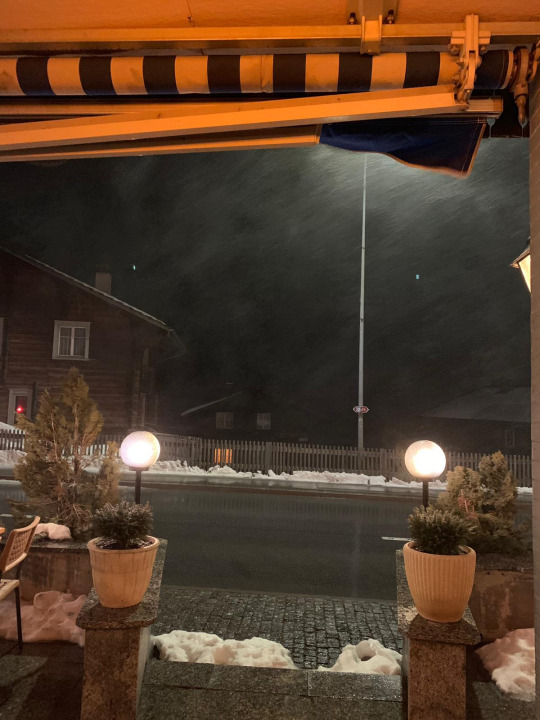
Morning brought delicious coffee and the classic Euro breakfast spread while making plans with all the k00ks who had rendezvoused at MtLodge With fairly heavy snow coming down, we decided to ride lifts from Dieni, a 10 minute walk from the hotel, over towards Andermatt and see how far we got. The forecast 5-10 cm turned out to be more like 20-30 cm and deeper in the wind loaded places. At Dieni, we made 1 lap before heading up and over into Val-Val where we kind of got stuck lapping a sweet stash of pow at least 4 times before punching it further West into the Oberalppass zone and ripping lines of powder varying from boot top to waist deep until lunch was called at the hutte there. When Mr. Mike and I tried to share a charcuterie board, the waiter either misunderstood or was taking the tourists for a ride, yelling "YOU ORDER, I MAKE" as we tried to clarify we only wanted 1 order.

Afternoon brought a few more laps on the Schneehuenderstck gondy before we started making our way back towards Dieni where again we spun run after run of virgin pow turns, finally some of us throwing in the towel at 3:00 after milking one more untracked zone. We took the sled run all the way back to Rueras and
MtLodge for drinks and a delicious dinner. More of the maggot crew had arrived.

Dieni
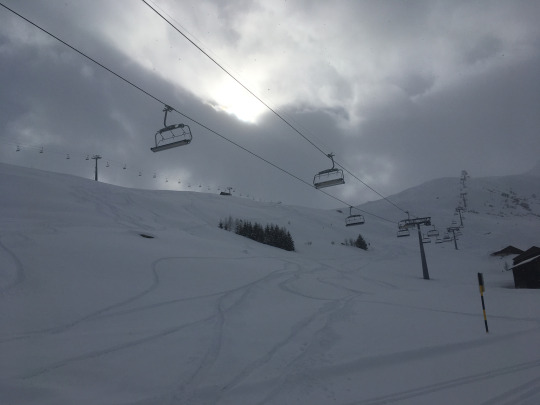
Next morning Tuesday, most of the fistful had targeted Andermatt, so we took the early train over and ramped and raged off the Gemsstock tram. Skiing the West couloirs first thing proved to be not such a good idea for some. After a warm up, a few of us went out to ski the Giraffe which only had about 15 tracks in it. We returned to it again later to find only 30 or so tracks. After a few more front side runs, the whole fistful took the Guspis down to Hospental which had wide swaths of uncut snow and the usual stunning scenery, ending with beer and dried meats at the Gotthard Haus before a train ride back to Rueras.
Guspis at 4:00 pm
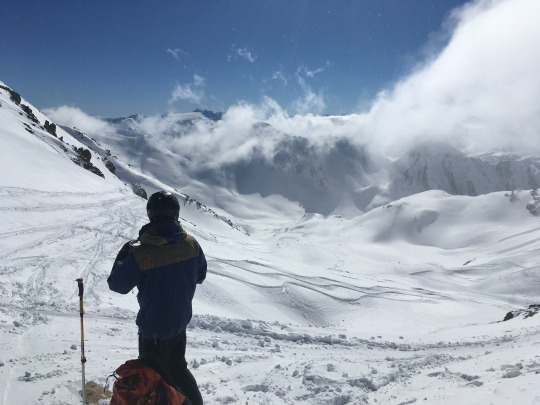

Skiing into Hospental
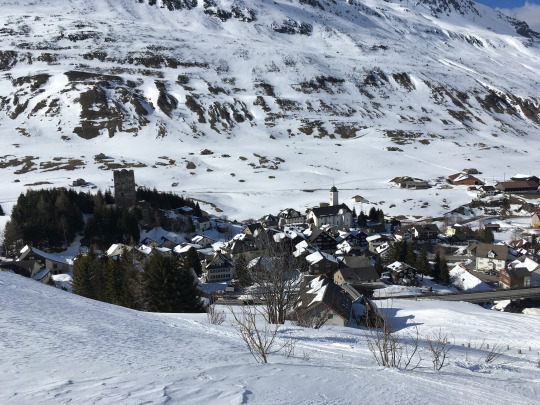
Next day, Wednesday, the host with the most, Michele at mt-lodge, had arranged enough transport for us to go over to St. Moritz via the Juler Pass and Bivio. Once at Corvatsch, the highest ski area in St. Moritz, we met Michele's
buddy Matteo who took us first down the Northwest couloir to ski acres of stunning pow, then over to Val Roseg past Piz Roseg and the Morteratsch Gletscher and down to lunch at Hotel Restaurant Roseg Gletscher which was
awesome. Then an ugly 37 minute long pole and skate out to Pontresina to catch the bus over to Corviglia where we took the 2 stage funicular and a chair ride. Then a little traverse and bootpack to drop into Val Bever with hectares
of uncut, Northwest facing powder skiing. The day ended at Gasthaus Spinas with beer and another series of train and bus rides back to pizza in Celerina.
Lunch of cream of asparagus soup with prawn at Hotel Restaurant Roseg Gletscher
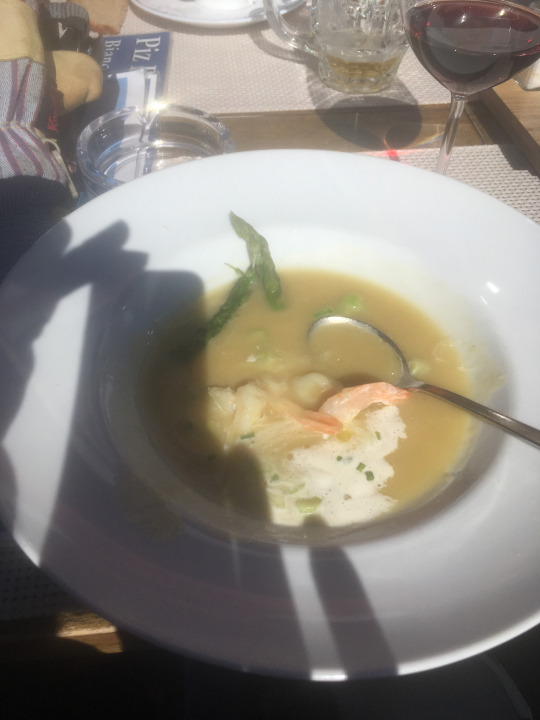
Icefall off back of Piz Roseg

Piz Roseg

****************************************************************************************************
Dropping into Val Bever




Thursday, the morning destination was Disentis, a 5 minute train ride to Acla da Fontauna and a short walk up to the tram.It was a gorgeous bluebird day with evidence of the suns heat on some of the south facing slopes. After a warm up, we took a short skin up to one of the entries to Val Strem to the West. With a little downclimb from the col into a couloir, we were set for a few thousand vertical of Northwest facing pow surrounded by rock and ice. We skied out to the train at Sedrun and hopped it, going West pver to Andermatt to meet with another portion of the crew. The afternoon was spent mostly skiing in the main bowl under the upper Gemsstock and finishing with a lap out into the Felsental where we continued to find good soft lightly tracked powder.
Val Strem entrance couloir

Scott smoking up the Val Strem pow

Val Strem from the bottom


Felsental

****************************************************************************************************
Friday, the last day at Rueras, we had planned to do the Oberalpstock, a well known descent of over 2000 meters, and one I had lusted after for a decade. North facing down into the Maderental valley. Michele had arranged for guides,
some Italian friends of his and we were off to start at 8:30 on the early Disentis tram. The original plan had been for the group of 17 to split into 2 groups, one to do the Oberalpstock, which has some technical parts, and the other group to take a more mellow tour down into Val Strem. Unfortunately, our guides were not comfortable with splitting the group, so some of us decided to not take the tour and instead ski pistes at Disentis.
The climb involved a fairly easy skin to start with then a bit of a traverse to a via ferrata that climbs a rocky section and leads onto another traverse followed by a short downhill section. I am notoriously slow on the skin track, so by the time we skied the short downhill section and started another longer climb, I was far behind the main group. At one point the skin track split with one variation going to the climbers left and up to the summit of the Oberalpstock itself. The right branch took a mellower ascent to a shoulder where the actual skiing down the North side began. I was convinced the group had headed up the summit and I was lagging, so I headed up intent on catching up with the rest of the group. But in fact, they had taken the mellower right branch and were waiting for me there. Hell bent on summiting, I argued in broken English with the guide, Rosso who relented and accompanied me to the summit where to my surprise there were no other members of the group. So I skied down mashed potato snow from the south facing summit and sidestepped to catch the group.
Oberalpstock traverse before via ferrata
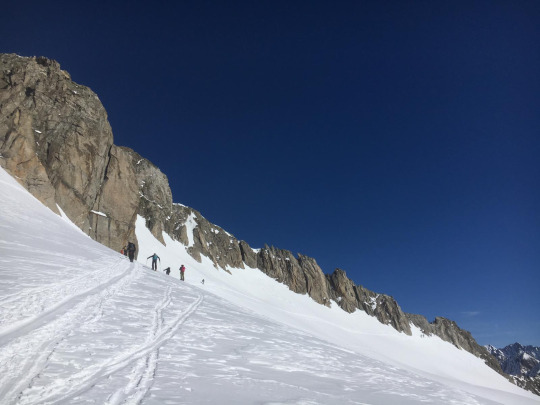


Climbing the via ferrata

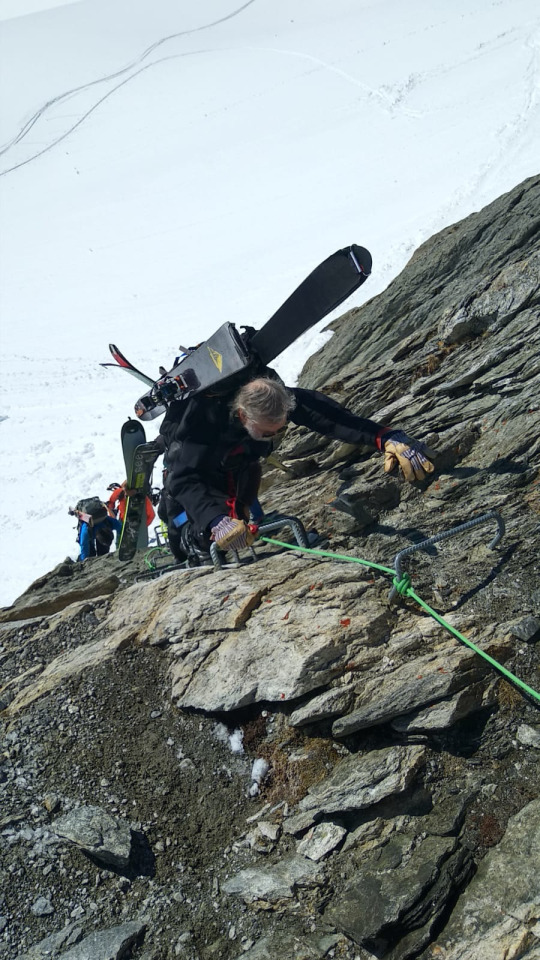
Oberalpstock summit selfie

View across first portion of Oberalpstock after via ferrata

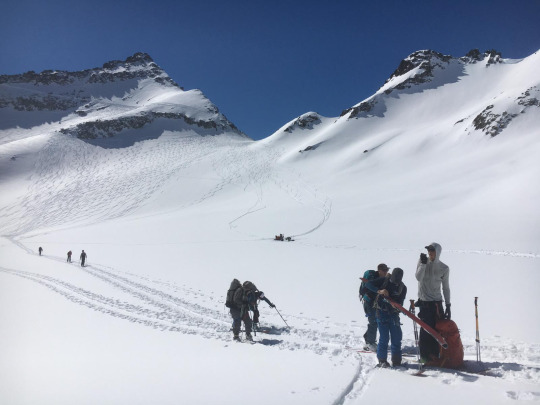
View from the Oberalpstock summit

Looking down into Maderental 2400 vertical meters below

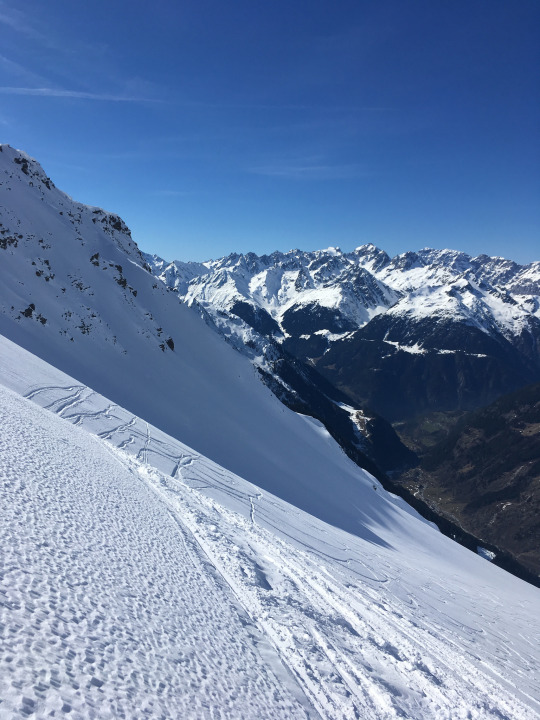
Skiing down the Oberalpstock
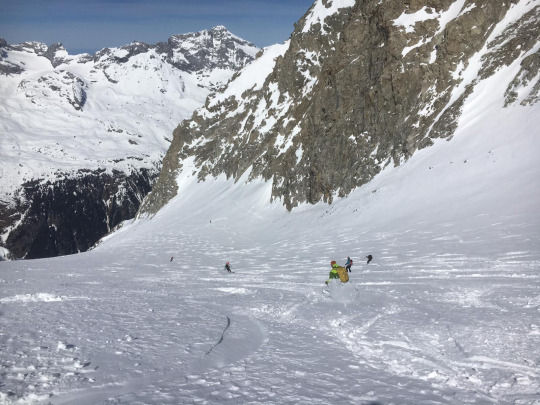
The Oberalpstock is enormous and despite a lot of tracks, we found sections of uncut, consistent steep pitches rolling North into the Maderental of vertical drop around 2200 meters. One section near the bottom was hard ice and the guides
set up ropes to help control that section.
Eventually we skied corn in an avalanche chute down into a cow pasture. It was an all-time route appropriate to end the trip.

Walking along the Maderental

Special thanks to Michele for organizing the trips to St. Moritz, the Oberalpstock and providing warm, abundant hospitality at MtLodge. Also thanks to my ski fiend pals Subtle Plague, bw_wp_hedonism and all the
maggot k00ks who showed up to sample skiing in the Swiss Alps.

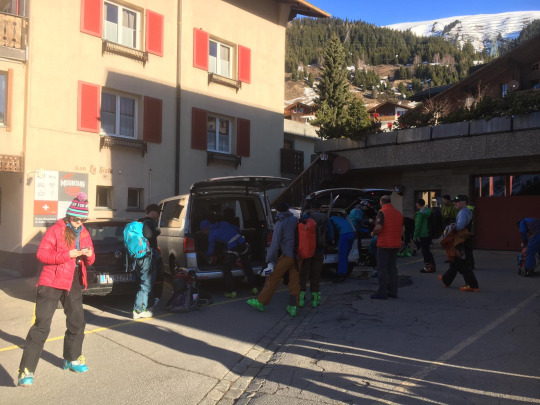
MountainLodge

1 note
·
View note
Text
Thanksgiving
It’s Thanksgiving here in Ketchikan (and everywhere else in the US) and the past few days have been an interesting study in island living. Tuesday Ladybug and I ran a few errands after her morning at the gymnastics club – they open it up to little ones one day a week and it’s a pretty awesome way to blow off some steam when the rains are hitting hard. Our first errand was to drop a package at the post office. Hot tip: if you’re ever in Ketchikan, and the line of one or two people at the post office right by the Alaska Marine Highway ferry terminal seems interminable, you can head five miles north and go to the post office in Ward Cove. Ward Cove as a neighborhood is just a blip: if you’re driving fifty up Tongass Highway (not, by the way, an actual highway by most people’s standards) you’ll have to downshift slightly as you go around the bend, the cove to your left, with its Fed Ex outpost and handful of float planes. The gymnastics club is tucked in next door to Fed Ex, in a converted warehouse. They moved recently (though before we arrived) and there was some grumbling about the jump in price: a 10-punch card for Tot Gym is now $40, up from $25. I could see how this would feel like a big increase. On the other hand, I would encourage anyone who’s actually mad about this to go to any indoor play space in a big city in the lower 48; it will cost at least twice as much.
Anyway, if you continue north less than a quarter of a mile, you’ll see the Ward Cove post office on your right. Tucked into the same little shopping strip – can I call it that? I’m going to – is a combo gas station/liquor store/pizza place, a hair salon, and the Green Bean, one of the best coffee places on the island. They roast their own beans – a good reminder that we’re living in… well let’s call it the GreaterPacific Northwest. I doubt anyone in Seattle or Portland is looking to Ketchikan for our coffee culture, but it’s here and it’s real. It’s similar to how good coffee is omnipresent in Amsterdam – walk into any office or home there and one of the first exchanges you will be a part of is “Koffie?” “Ja, lekker.” I think the weather and the dark winters foster this attachment to warm deliciousness, which is fine by me. I’ve always been a fan of a hot drink on a cold day.
All that to say: you’ve just experienced Ward Cove. You could continue north and you’d never know that you missed a magical feature of the island. So instead, turn inland from Tongass Highway via Revilla Road (within a very short distance, you’ll be fully surrounded by Tongass National Forest), then turn onto the road with the brown campground signs and you’ll hit Ward Lake, with its forested loop. The first time Steve and I did this easy little hike, he told me he’d Vision-quested it: as in, when we were trying to escape Los Angeles like we were in an old Kurt Russell movie, he pictured what he wanted, and the Ward Lake loop was it. Dark and mossy, it’s the kind of path that desperately wants to grow over itself; but for all the pesky walkers, it would undoubtedly succeed. In the time of the WPA, folks up here erected several wood and stone shelters with fireplaces – after a walk or a fishing expedition, and even in the pouring rain, a person could have a pretty excellent picnic, looking out at the lake. The last time Flo and I were up there, someone had made a fire and left it burning; the little cabin beckoned us, and we sat by the fire and warmed up.
So that’s Ward Cove andWard Lake. But back to the post office. It was raining (I forgot to mention: it’s always raining now) and Ladybug whimpered about not wanting to get out of the car again. So I gave her an apple, I locked the doors, and I left her in the car. It’s worth noting that there have been incidents of arrests for leaving small children in parking lots in big cities and suburbs. It’s also worth noting that I wouldn’t have left her alone in the car even in our gatedcarportin Los Angeles. But if you could see this post office, you’d understand. There’s just no reason to imagine that a child wouldn’t be safe there. And of course if you’re reading this in a small town like Ketchikan, you’re probably wondering why I’m bothering to mention it at all – of course a five-year-old is okay on her own, in a parking lot, for three minutes, especially with the doors locked. What could possibly happen? It’s just such a shift for a kid raised in New York, who started raising her own kid in LA – places where anythingcould happen.
Errand number one: done. It was back to town and into Island Pharmacy to pick up a prescription. Island Pharmacy is one of three pharmacies in Ketchikan, and it’s the only one that’s independent (the other two are at Safeway and Walmart.) It’s also a single minute from our house. While we were in there, one of the women working behind the counter mentioned that she still needed to go shopping for Thanksgiving.
“Don’t,” said the older woman paying for her prescription.
“Uh oh,” I said. “Are the stores crazy?”
“Yes,” she said. “And there’s nothing on the shelves.”
I’m not sure I’ve mentioned this on the blog before, but it is possible to walk into a grocery store here and find that they’re completely out of, say, eggs. And I mean completely out. Not, like, you might have to buy brown instead of white, or the only ones they have are the $7 cartons where the chickens sleep on memory foam mattresses and only eat kale. (I’m usually somewhere in the middle: uncaged, ideally organic, but I don’t need the chickens to have been massaged on a daily basis.) There are simply no eggs, and any plans you may have had involving eggs will have to be put on hold. So the idea that the shelves were wiped clean was not a crazy one.
Flo got home early that day, so the three of us hightailed it to the grocery store. As we’d been warned, there were some gaping holes. No heavy cream. No egg nog. And, as a lady told me grumpily in the produce aisle, no canned sweet potatoes. We had a long talk about how many fresh sweet potatoes she’d have to use to make her casserole, which normally required three cans; this conversation felt so backwards that I wasn’t even sure I could be helpful, but I tried.
In the end, we got everything we needed. We’d already found a pasture-raised turkey (read: the kale-eating kind) a few weeks prior (two turkeys, in fact; we did a test run when our friend Charlotte came up – Flo made a full on Thanksgiving dinner for her birthday.) It’s Thanksgiving morning, the turkey is thawed out, I have some pumpkin and cranberry-related items to start making, and my parents will get here tonight. When people ask when they’re coming, I say either “Flight 67” or “the 5:00 ferry,” and everyone knows what I’m talking about. It’s like living in an extended episode of Wings.
Last year, our family was one of millions who drove east out of Los Angeles the day before Thanksgiving. We were headed to Castle Valley, Utah, to my sister-in-law and brother-in-law’s magical place (Flo and I got married there, in the shadow of Arches National Park.) It took us two hours to drive twenty miles; we pulled over and had dinner, after which things picked up a little bit. Flo showed me a picture of that same exodus a year later – lines of unmoving cars, brake lights illuminating the freeway. This year we’ll be driving a mile and a half to pick up my parents from the airport ferry.
I’m thankful for a lot of things today – for Ward Lake, and for the Ward Cove post office with its empty parking lot, save a small apple-eating girl. For Green Bean coffee, and the local pharmacy, and the fact that I can live without whipped cream on my pie (BUT JUST THIS ONCE.) For the people I’ve met here, and the people I haven’t met yet, but will. For the sunshine and long days we had when we moved here, and for the rain and the darkness we have now. For the two people I live with whose hearts are all wrapped up with mine, and the third little person who’ll be joining the party soon. And for all of you, wherever you are. Happy Thanksgiving from southeast Alaska. Please eat enough whipped cream for me.
6 notes
·
View notes
Photo
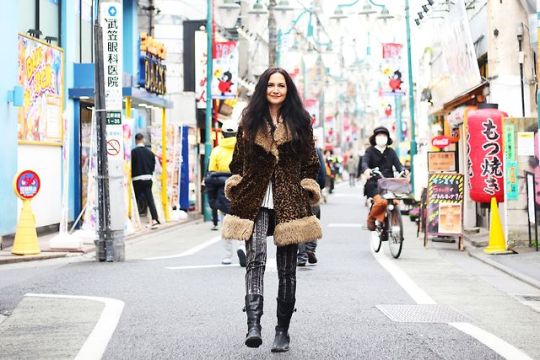
NIPPON GA DAI SUKI (JAPAN WE LOVE YOU)
Traveling to an exotic country sounds, well, exotic. And it is. It’s a true adventure in life. It’s also exhausting. And enlightening.
I’ve traveled afar throughout my entire adulthood. All over Europe, The Middle East, Egypt, Central America, Mexico, Eastern Europe, Canada, the Caribbean, Australia… Florida. ;)
I give travel (and my parents, *ehem*) credit for keeping me grounded, humbled and modest, in the sense of “I AM BUT A SPECK ON THIS EARTH” or “MY BELIEF SYSTEM IS NOT EVERYTHING” or “I DON’T KNOW AS MUCH AS I THOUGHT I KNEW” or “I REALLY DON’T KNOW HOW I GOT BEST DRESSED IN HIGH SCHOOL” (read: France ;)).
Travel helps us all to get out of our comfort zone and to see what a tiny place we occupy on this planet. It’s a liberating realization, embracing one’s insignificance in this world. It’s not about being small, because none of us are. It’s more about the world being BIG.
Travel puts your life into perspective; your problems and celebrations do not hold as much weight as they seem. It also shows you how much you have or what you don’t have. It’s a healthy reality check.
That’s why travel is good for you.
I am reminded this after a crazy year. My husband and I have been on tour with our music (The Smoking Flowers) for a lot of 2018, in and out of the country. It’s been a healthy year of these reality checks for sure.
That’s why I am writing this post on my health blog, as this type of health is just as important as the physical.
And so I write.
I write to journal.
I write to inspire (myself, if no one else).
I write to remember.
I write because I am bored today, it’s cold outside and my matcha is steaming, infusing me with memories.
I’m also writing because I miss Japan.
Of all my travels, I think Japan smacked me across the head when I needed it most. It made me feel like I was five years old again. Everything, down to using the toilet, I had to relearn/rethink. Yep, it took 43 years off my life. Now that’s a natural youth serum I can live with.
It also made my brain function differently. Trying to learn a foreign language audibly and visually that has no history in the Latin world is truly a foreign language. I now know how to order water, draft beer, sake and vegetarian ramen in Japanese. Basics. (Although a friendly laugh is usually the response to the veggie ramen inquiry). I now know how to tell a Japanese punk band they did a great job after seeing them open up for us at our show. I learned to say just plain “awesome”, and used it a lot. Japanese is pretty “saikou”, after all.
Japan can feel very futuristic, and Tokyo is like being on a movie set at times. They are the future for most of the civilized world seemingly 10 years ahead of us all, yet still remaining ancient and historic at the same time. Eating sushi or having tea can be presented like it was 400 years ago or like something out of The Jetsons (ala conveyor belt computer sushi restaurants).
But beyond the exotic veil, it was the culture and etiquette that really impressed me and made my head spin.
Below are but a few observations of the plentiful Japanese culture I experienced over my month long visit. And of course, they are my own, so they are neither right nor wrong. Just observations from a somewhat worldly gal who grew up Southern in America:
1. The Japanese have manners like I’ve never seen.
They are unwavering in their politeness. Selfless hospitality is a cornerstone of Japanese culture, and you can feel it in everything down to their quiet nature to their cleanliness to the way they package your purchased goods like a present. And that bow! That Japanese bow. It makes you feel special.
2. They are startling quiet and calm.
Given that Tokyo houses more than 13 million people, the sense of order and calm as everyone goes about their responsibilities with concern for others is remarkable. The Tokyo city streets are shockingly silent. You can hear the air, the machinery hums that run a city and the cars passing, but they don’t honk like NYC. I think I heard two honks the entire time in Tokyo, and that’s not an exaggeration. We drove the interstates a ton on our tour, all over the country... aggressive driving doesn’t seem to exist. Could this be from their Zen culture?
Also, they don’t bump into you trying to get on the subway in a hurry. It’s an orderly line and gentle squeeze to fit everyone on the trains, like a can of sardines without the stink.
I want to throw in another aspect of “calm” here; safety.
Feeling safe, stable, and secure is central to our health and wellbeing. How safe we feel at home and in our neighborhood can influence our social habits and feeling of freedom. When we feel safe, we find it easier to relax, do all the things that comfort us, and focus on the work or study we need to do to help ensure our stability.
I’ve never felt safer anywhere in my life than when in Japan. I never worried about my purse or goods being stolen. Never worried about locking our apartment or car doors. Never got ogled at or hit upon. Wowza.
3. There’s no trash on the streets. And I mean zero. Not even cigarette butts. And it’s not like there are janitors sweeping the streets and alleys. To make this fact more amazing, it’s hard pressed to find trash bins anywhere. So where does a city of millions dispose of their goods while walking/biking about? Their pockets… until they reach home to throw in appropriate bins.
RETRACTION: One time we were walking under an over pass in Tokyo and we saw, gasp, trash. The remarkable thing was that this trash was piled neatly in a small pile, waiting anxiously to be picked up properly.
For an interesting article on Japan and the waste culture check out this article: https://www.weforum.org/agenda/2017/07/why-japanese-dont-litter/
4. They seem to really care about the planet.
And don’t just post about it on social media.
You won’t find paper towels anywhere, sans a few nice restaurants. Water waste is thoughtfully considered in everything they do it seems. Yes, even the toilet fill water after a flush is used as a sink to wash your hands before entering the tank. They line dry their clothes (like most of the world except America). They ride bicycles like it’s Amsterdam on steroids. There are even parking lots just for bikes. This eliminates the need for excess taxis on the streets (i.e. “fossil fuels”). I know this goes on all over the world, but I again, I’m sticking to Japan here.
5. Buddhism and Shintoism.
I have practiced Buddhism since my 20’s and see it as more of a mind set and lifestyle than a religion. So for me, I felt right at home in a country that houses over 77,000 temples (No typo there). Incense permeates the air, especially in Kyoto. Smelled like my house and I couldn’t have been happier about that aspect.
But it’s more than Buddhism. The main Japanese religion is Shintoism. Many Japanese people practice both. The beliefs are very compatible and not contradictory.
6. ROBOTIC TOILETS!
Japan has a magic thing called Toto Toilets. And the toilet culture there is really something to behold. I fell in love with their toilets and never once worried to sit on the public toilet seat. I can simply not go back to our classic Kohler again. Trust me, once you experience a heated seat, self-cleaning, massaging, butt-cleaning, “privacy sound”, hand-washing toilet all in one small package, you’ll never go back. Don’t know how to expand on this in a blog… just “go” try it for your self.
7. 7- Eleven heaven!
Yep, you heard this health advocate correctly. When you are looking for a healthy bite on the road or on the quick, there’s a 7-Eleven on every corner. And it’s not the 7-Eleven we know in this country at all! Made fresh daily veggie sushi, veggie rice “sandwiches”, miso soup, raw veggies, healthy drinks, tea, fairly healthy snacks if you are into the packaged food thing. All for super cheap. I cannot tell you what a lifesaver it was on the road for us when there were practically no healthy options. Also, we decided to add fish into our diet while in Japan, and certainly glad we did. I’ve never had better fish in my life. It really felt healthy. My nails are still shiny like they’ve been shellacked. Win win.
8. VENDING MACHINES!
Super convenient and anonymous, there are vending machines all over Japan (even in remote villages) that can get you most anything you need instantly: from fermented bean drinks to green tea to hot or cold coffee to fully cooked meals to used panties. Yep, the Japanese can get weird.
Ok, so maybe the last three points are less about culture, but I had to throw them in for the “wow” factor.
I could go on and on about Japan… it’s as wide and deep and old and beautiful as it’s countryside beacon Mt. Fuji. But it has its pitfalls too. No culture is perfect. I just prefer to focus on the ideals I look up to, rather than focusing on the negatives. Their negatives are no different than America’s: too much sugar and meat in the diet, it’s a highly misogynistic society, cigarettes, stressful six day work weeks with long hours, those darn plastic bags… But we all know those are WORLD WIDE ISSUES.
Japan, you definitely stole my heart. Thank you to all who came to our shows and to those that showed us your rare style of hospitality. And a huge special thanks to my tour manager, Gus Bennett, who introduced my husband and me to this beautiful country, showed us the ropes and helped us navigate into this great unknown that will certainly be with me forever.
Mata, chikai uchini, aeruto iine.
Photo credit: Marley Parker at ML Parker Media
#travel#japan#tokyo#kyoto#health#writing#culture#lotuseye#ownyourohmhealth#thesmokingflowers#kimcollins#buddhism#shinto
1 note
·
View note